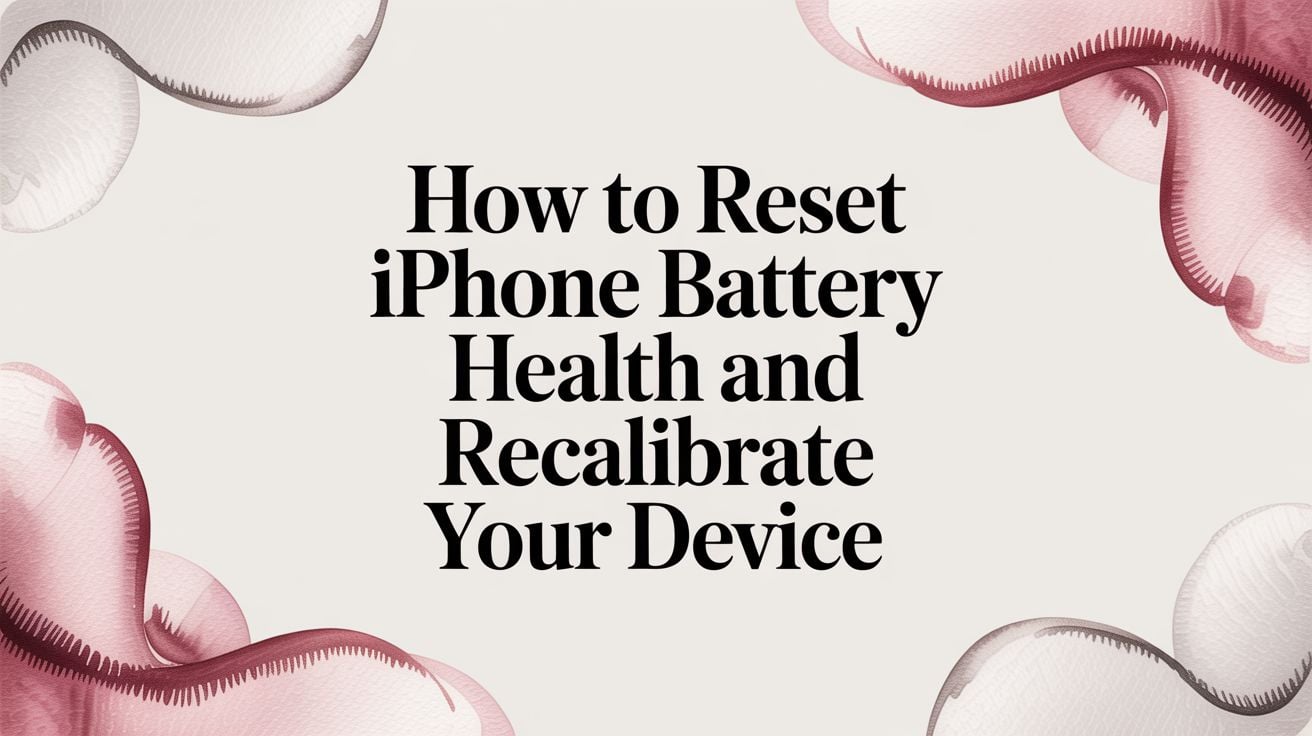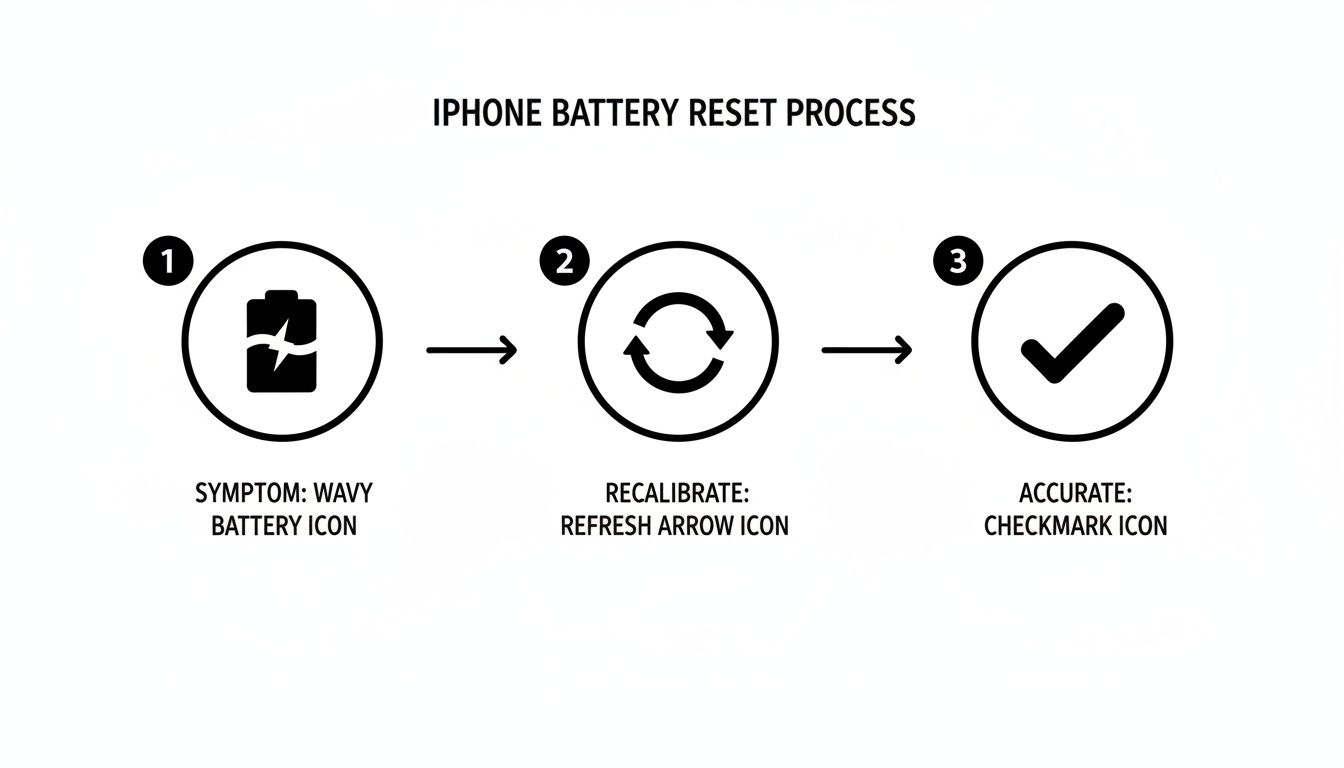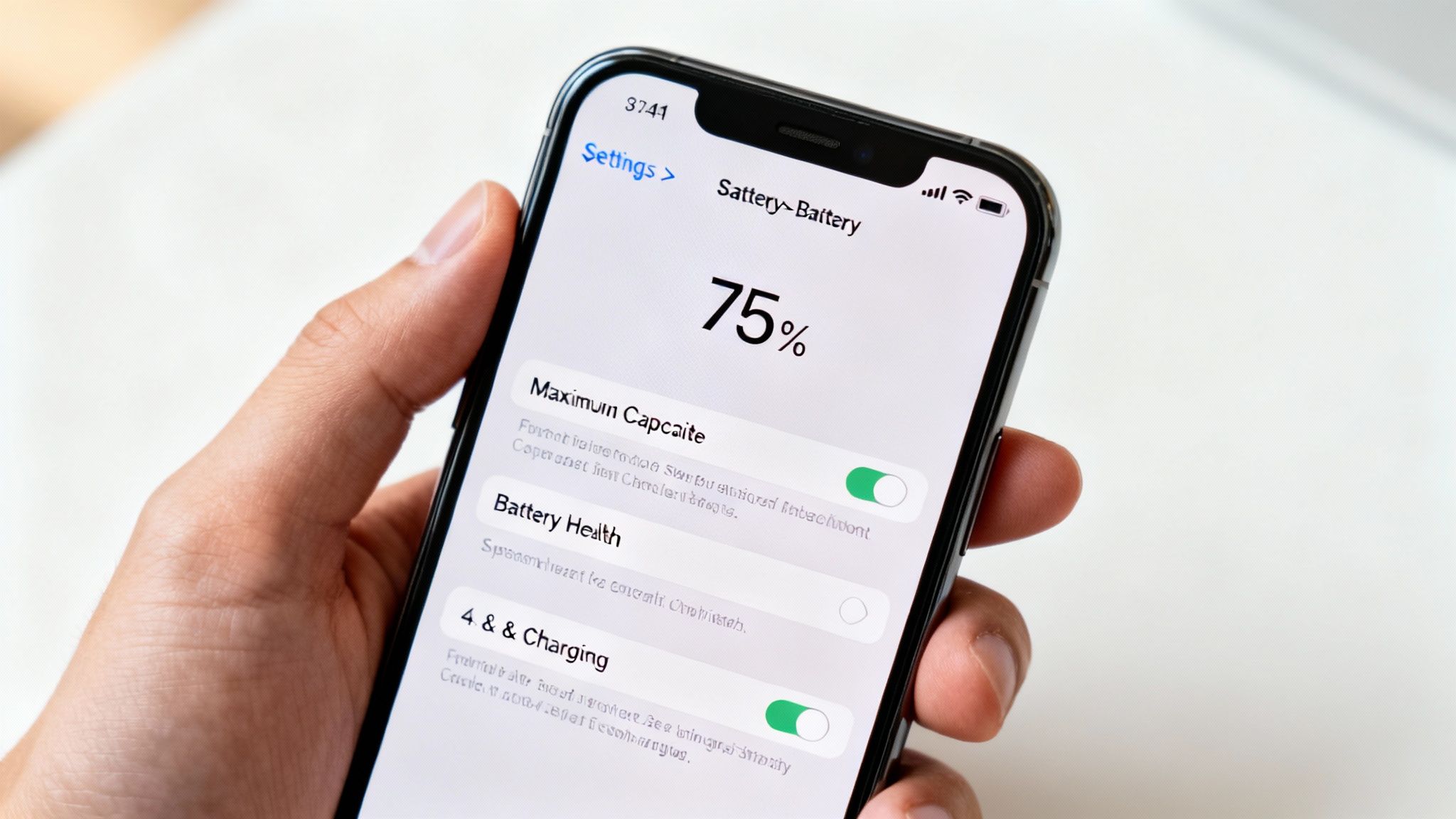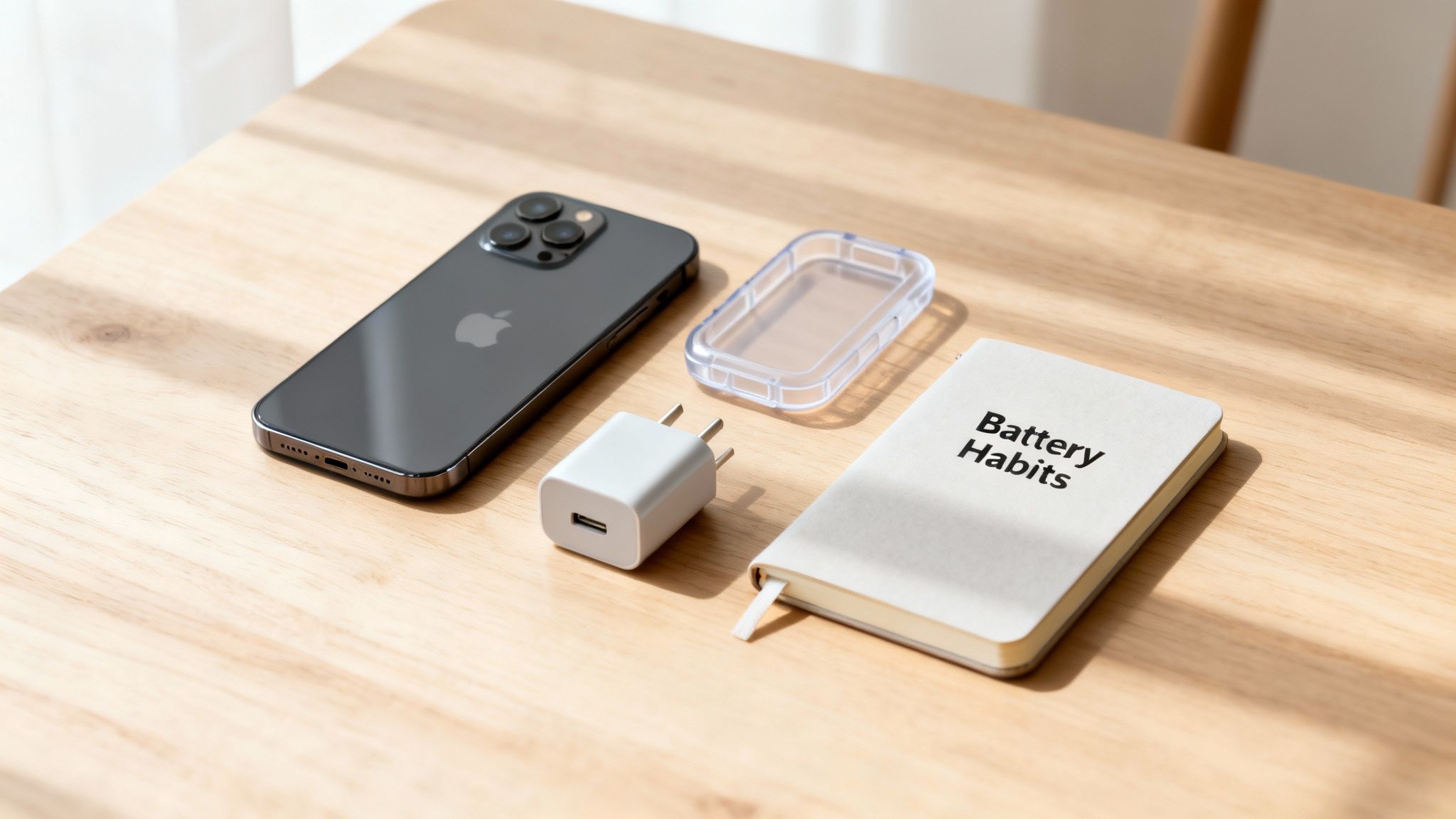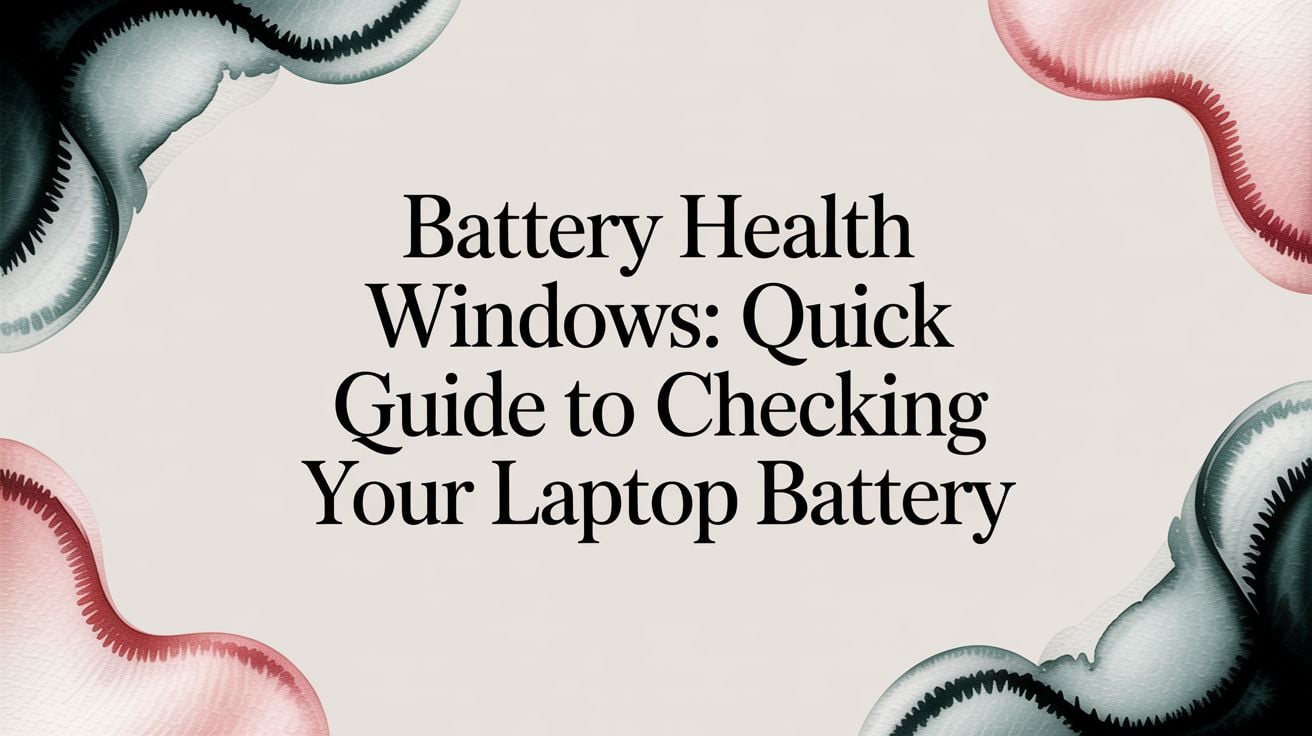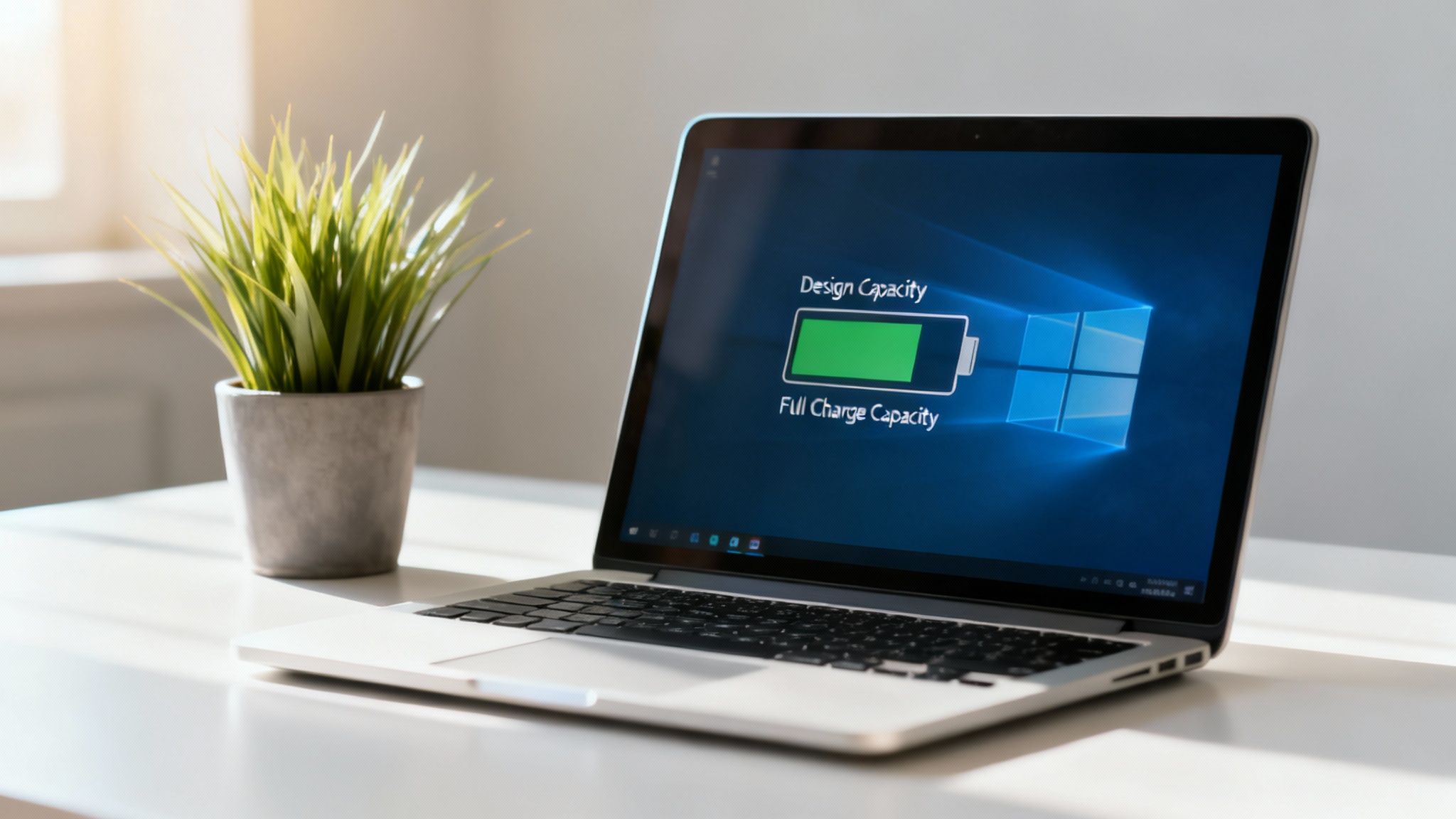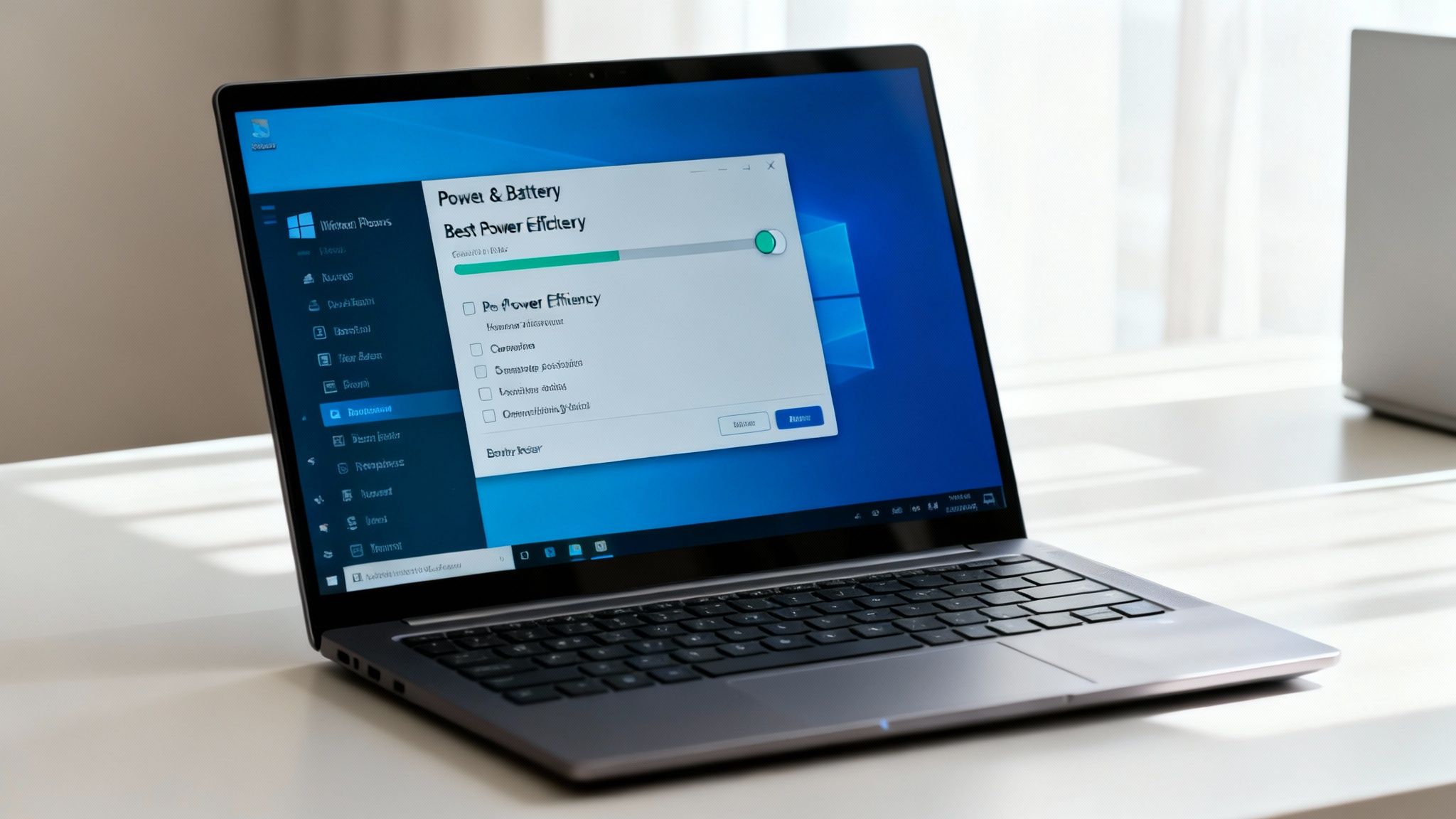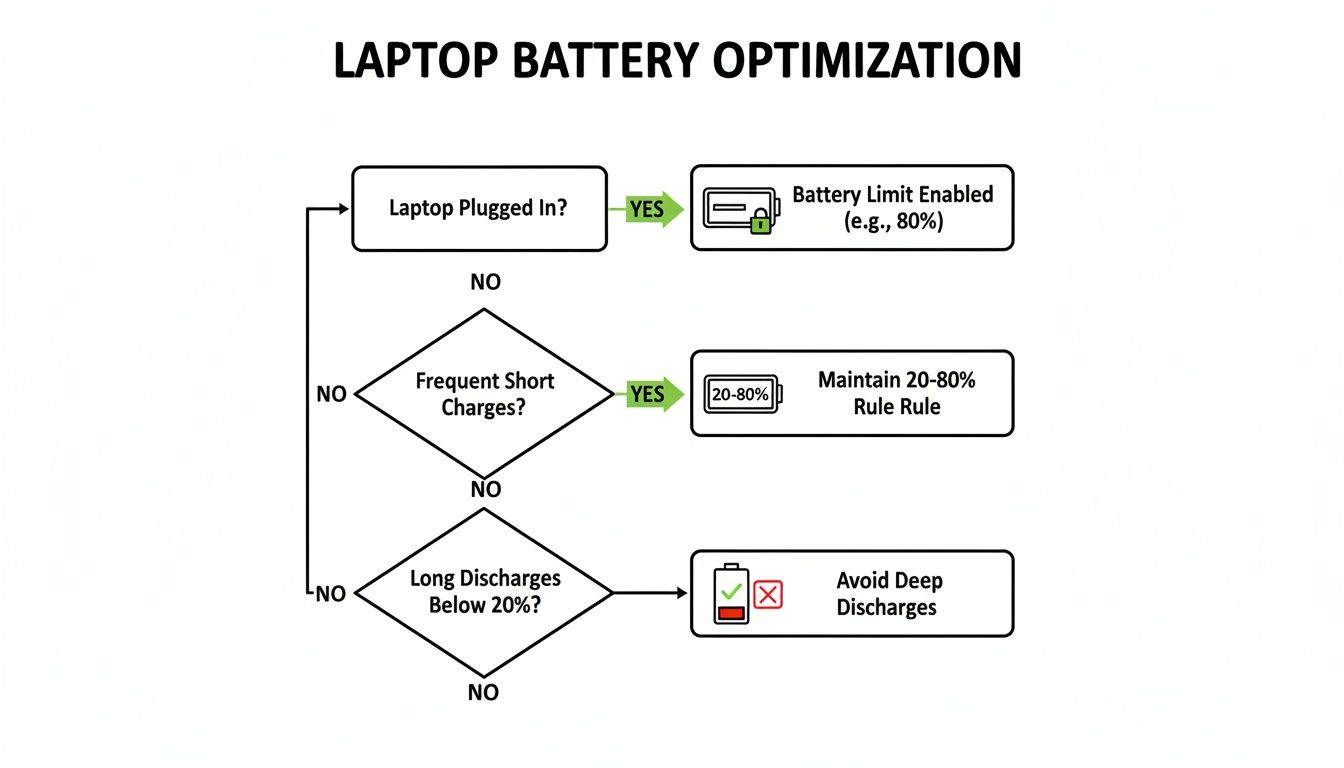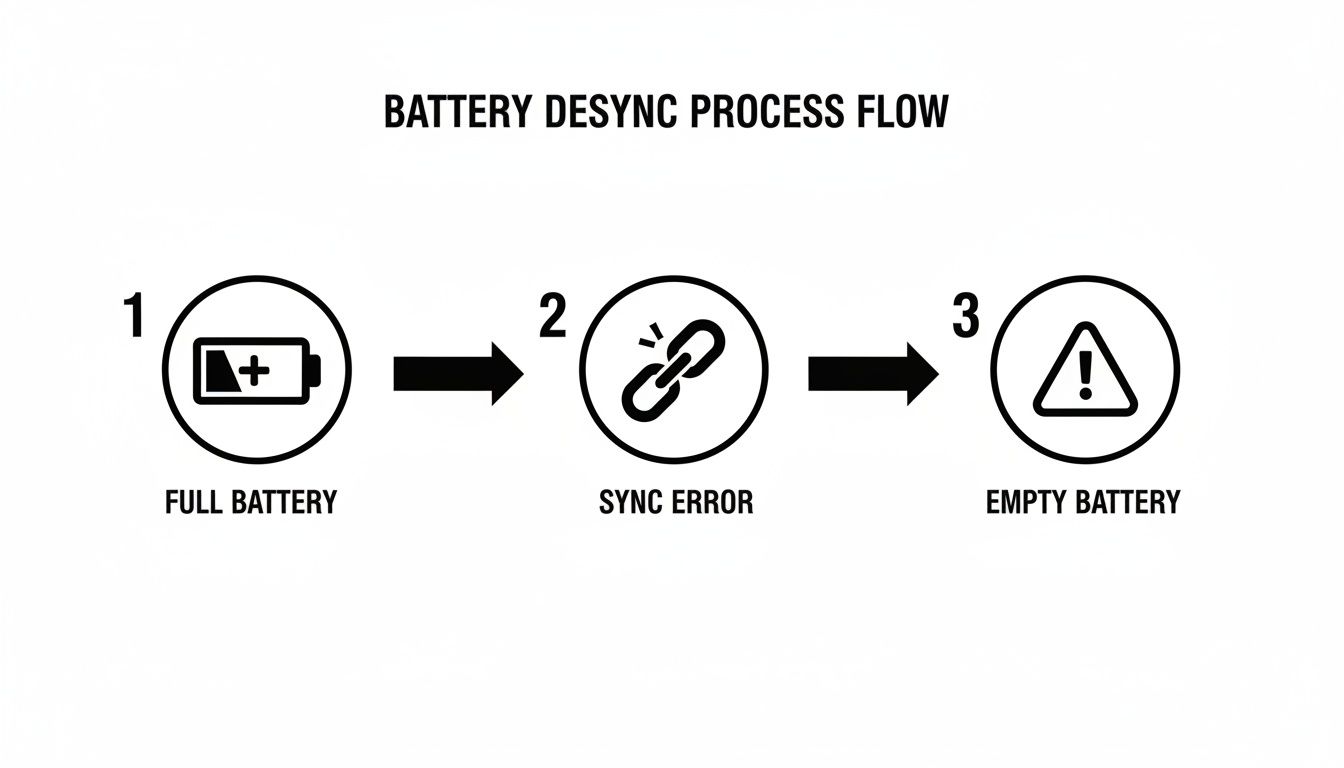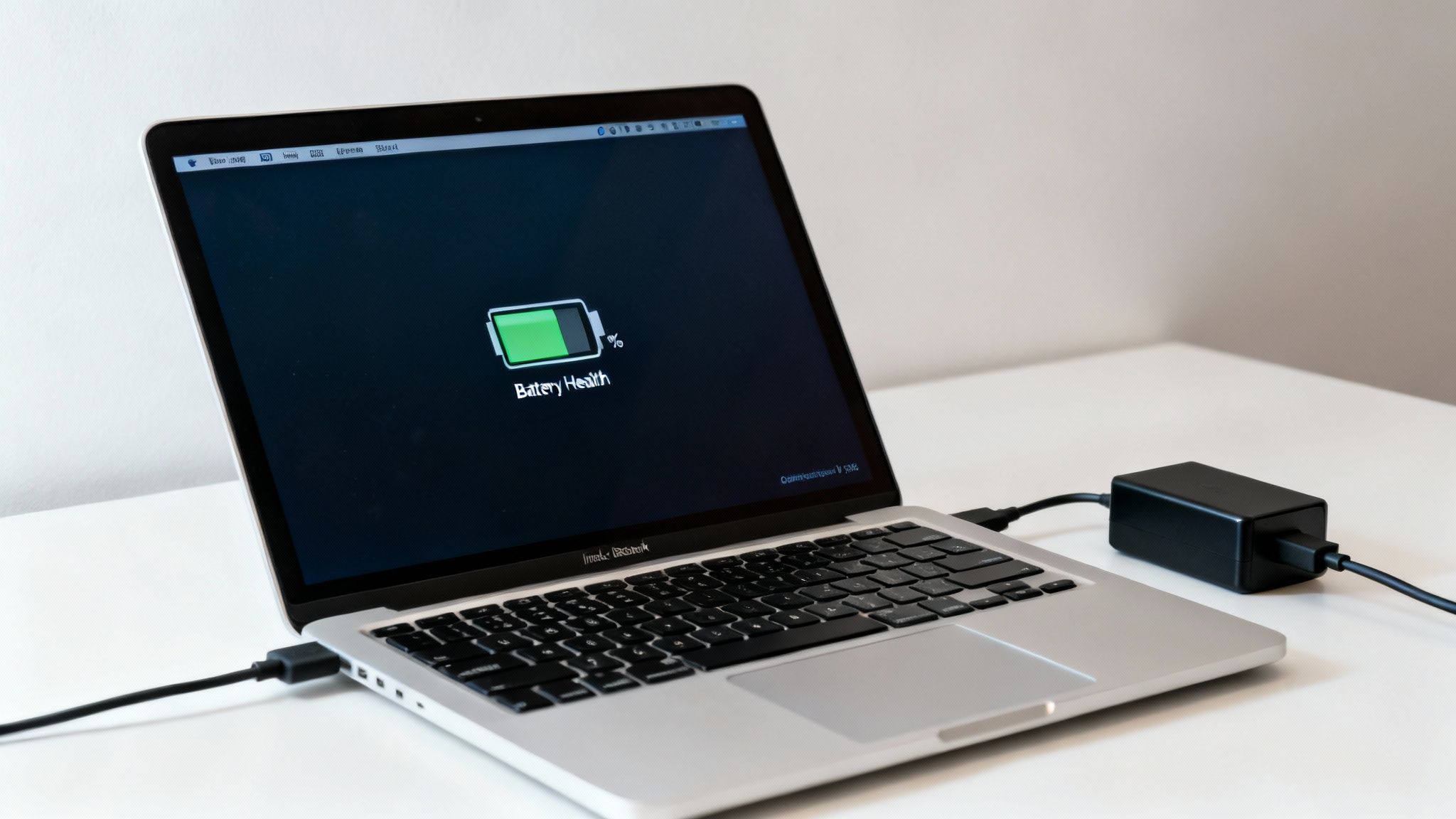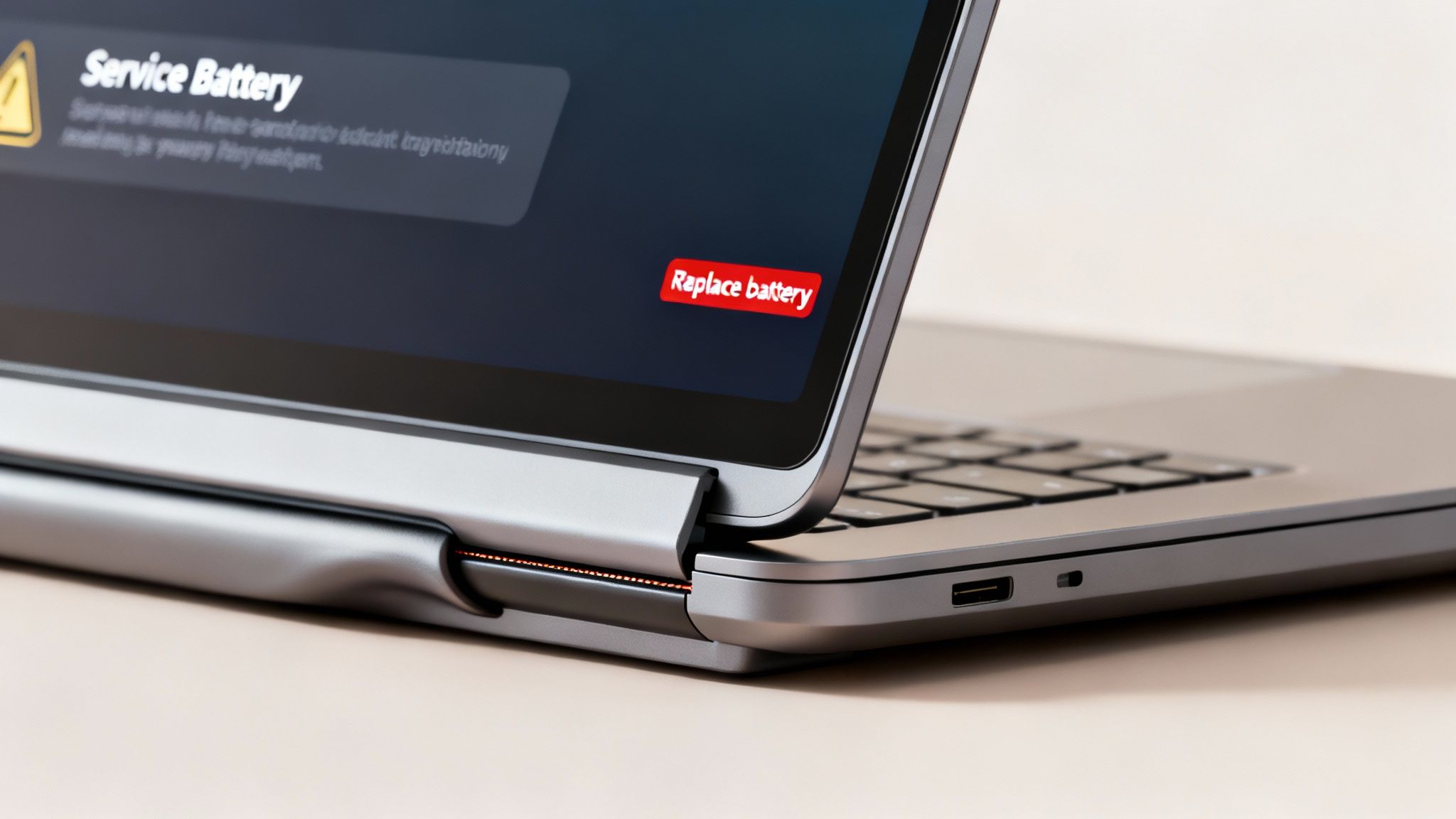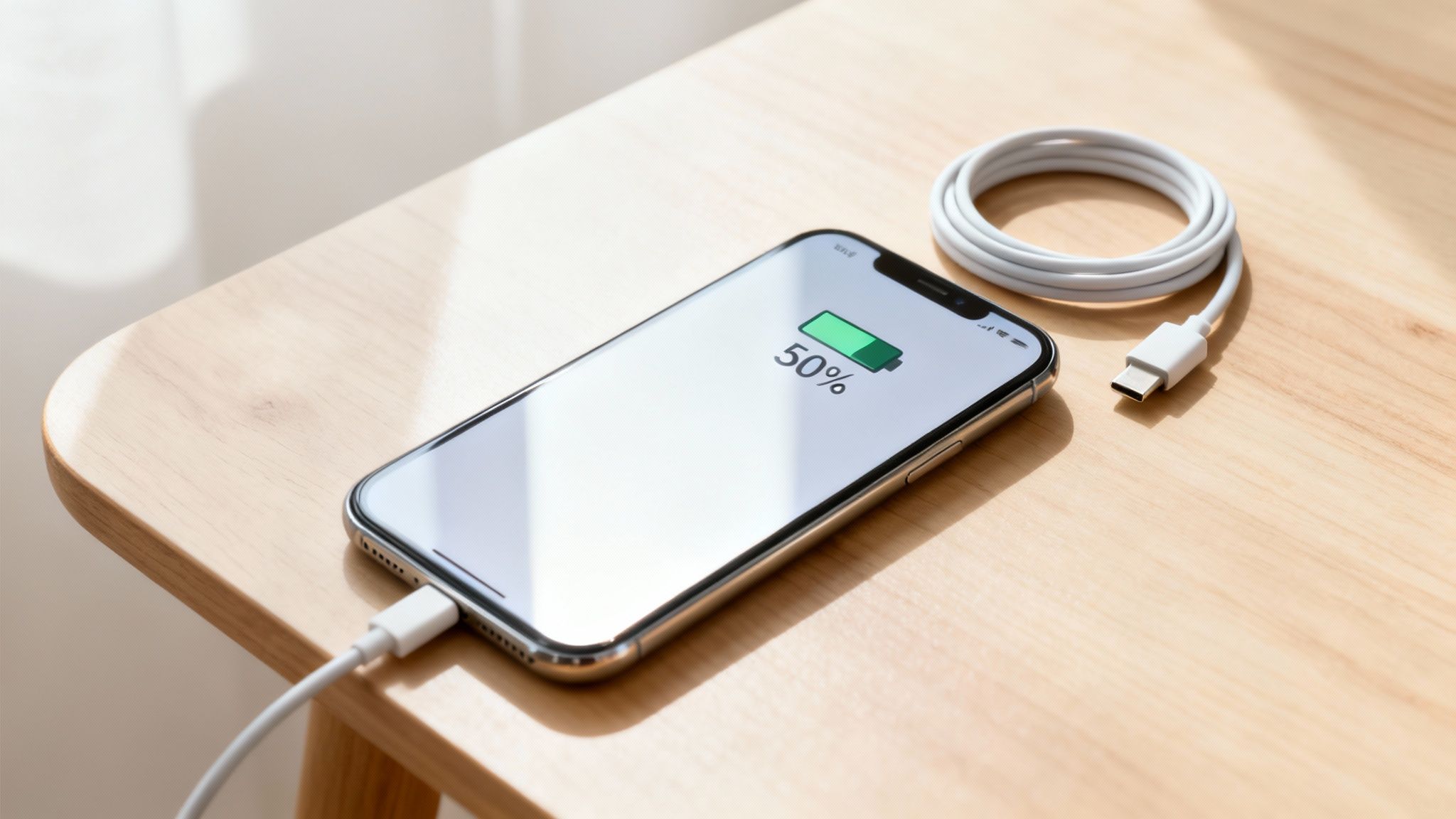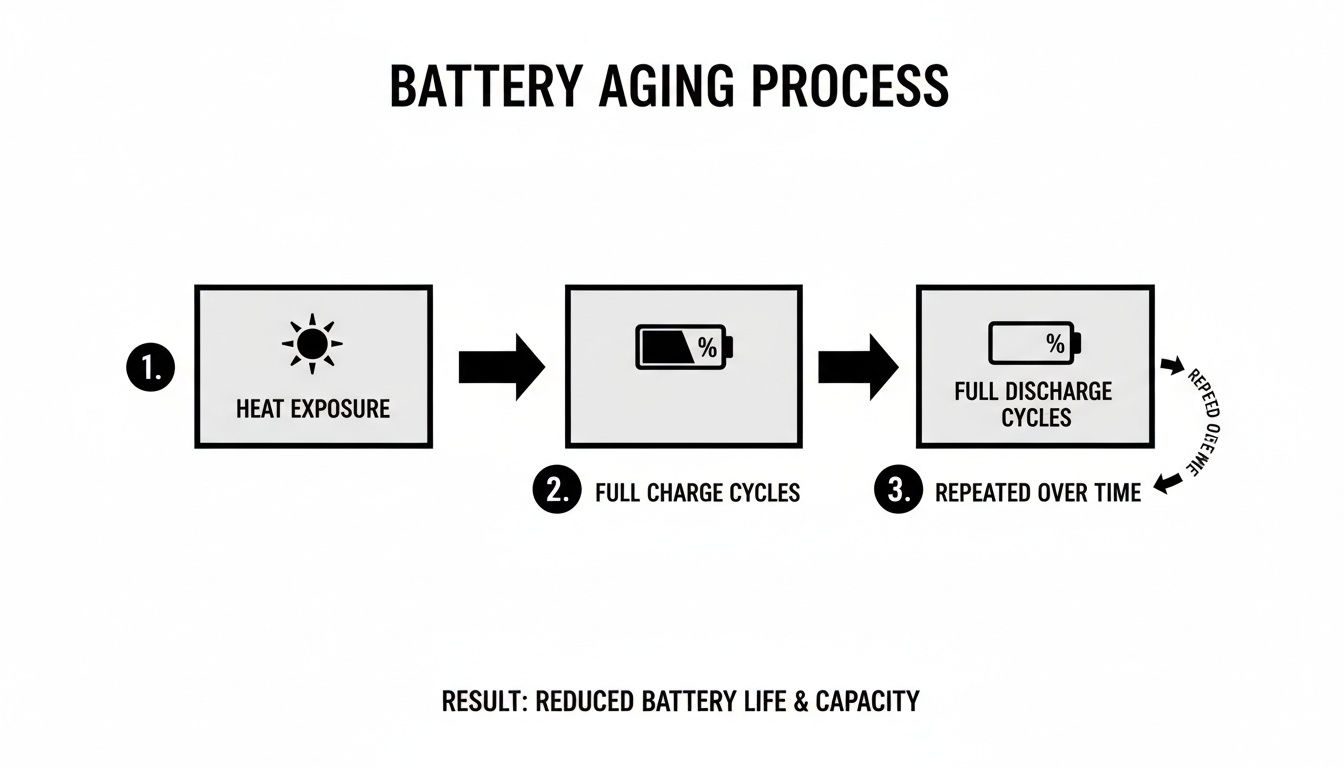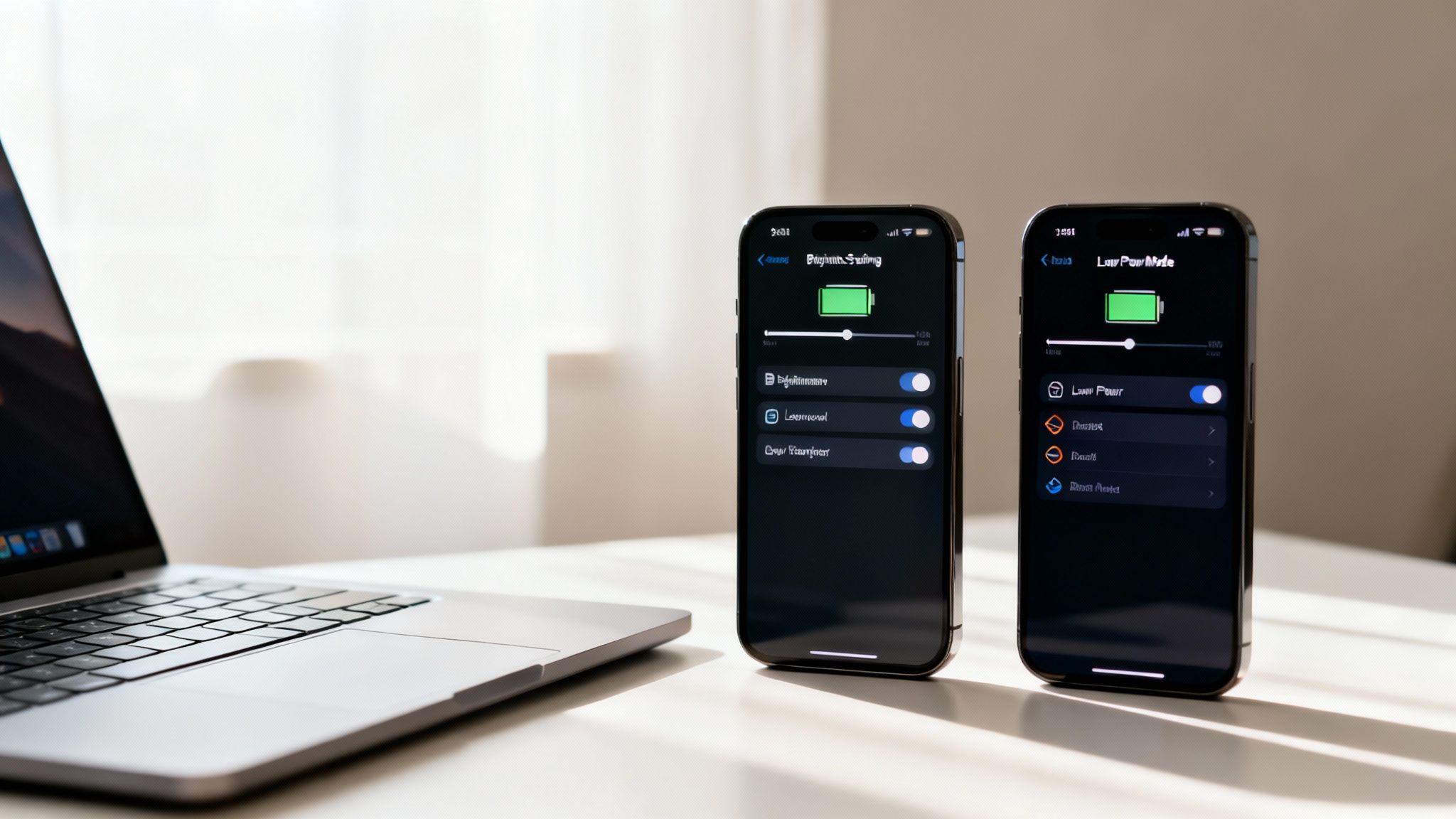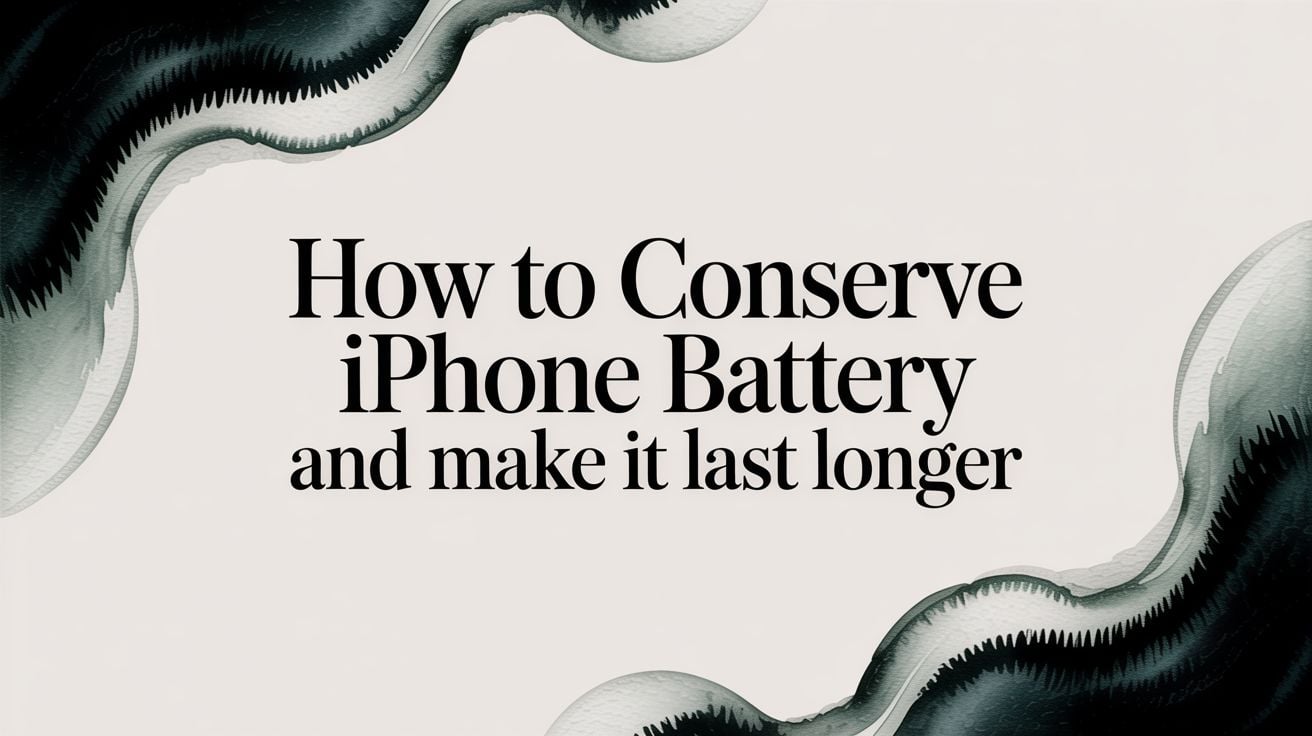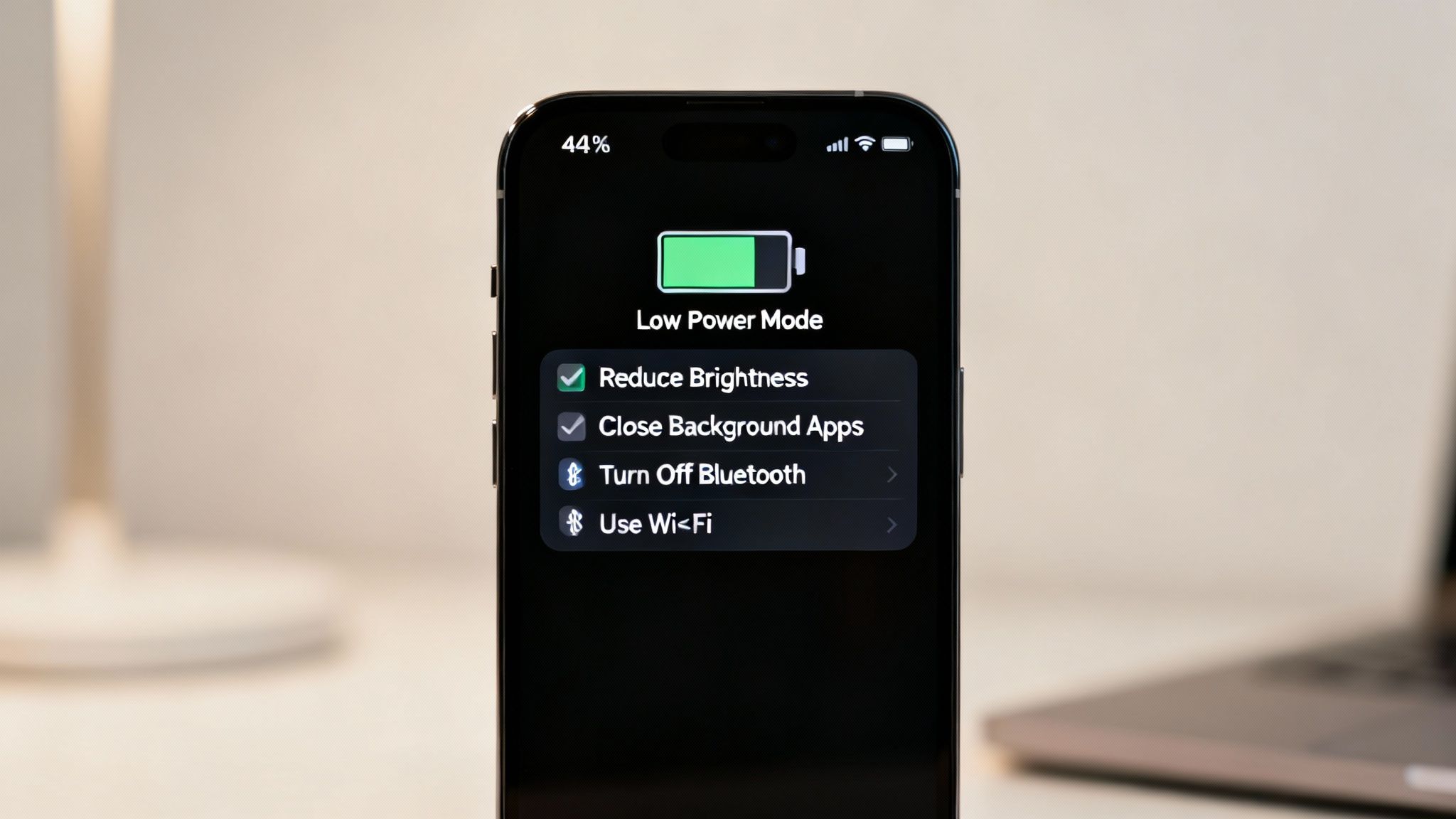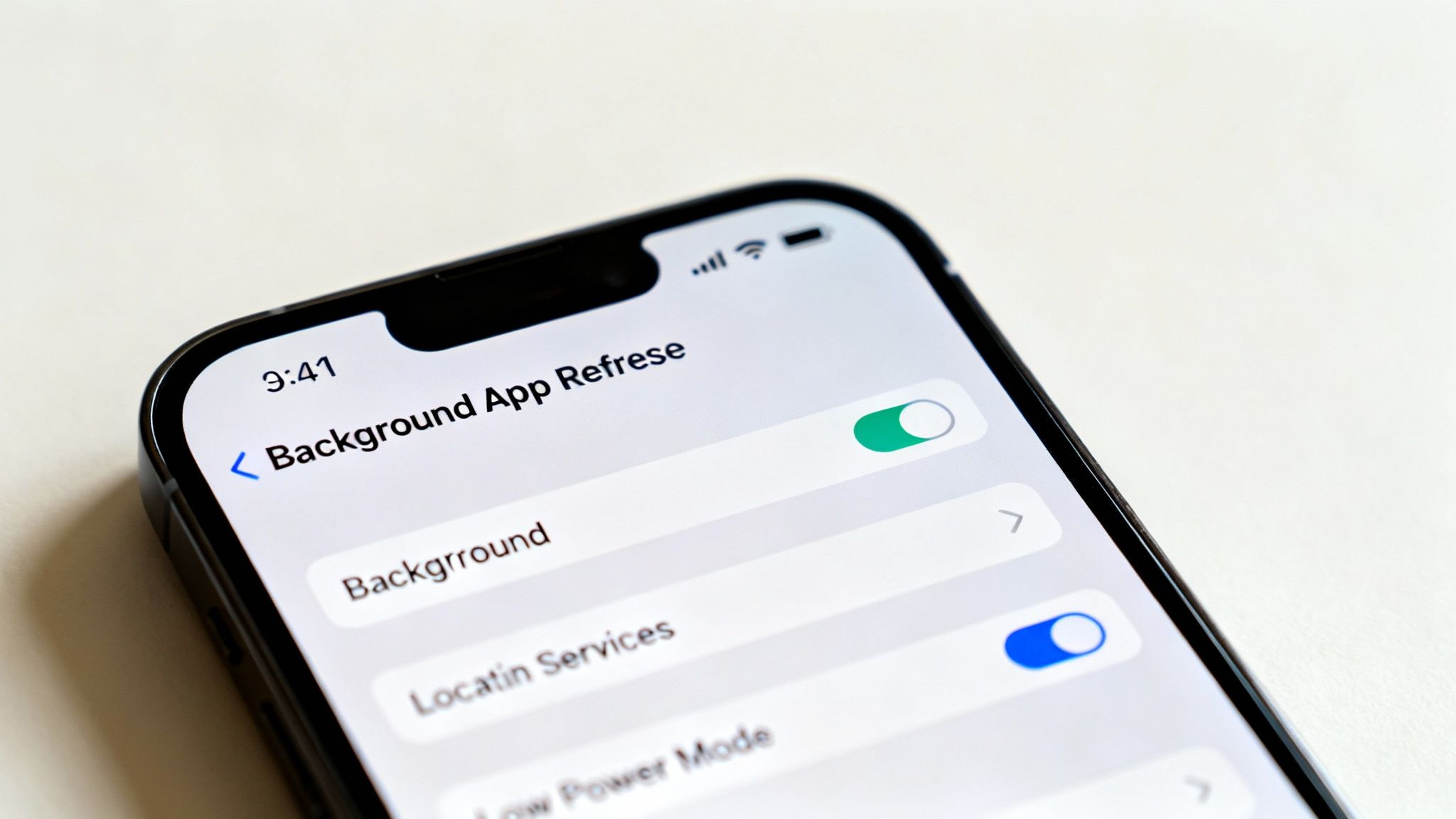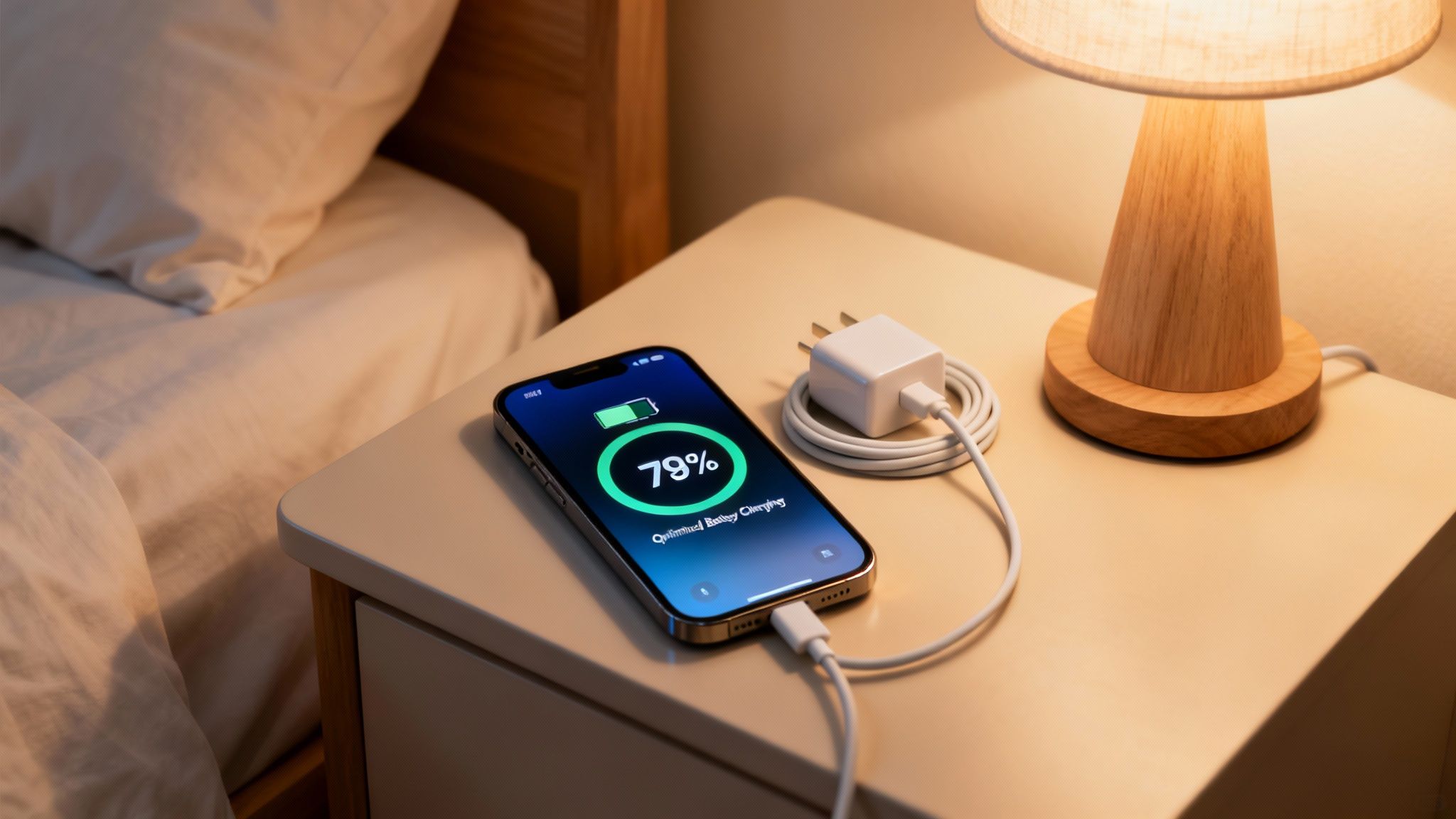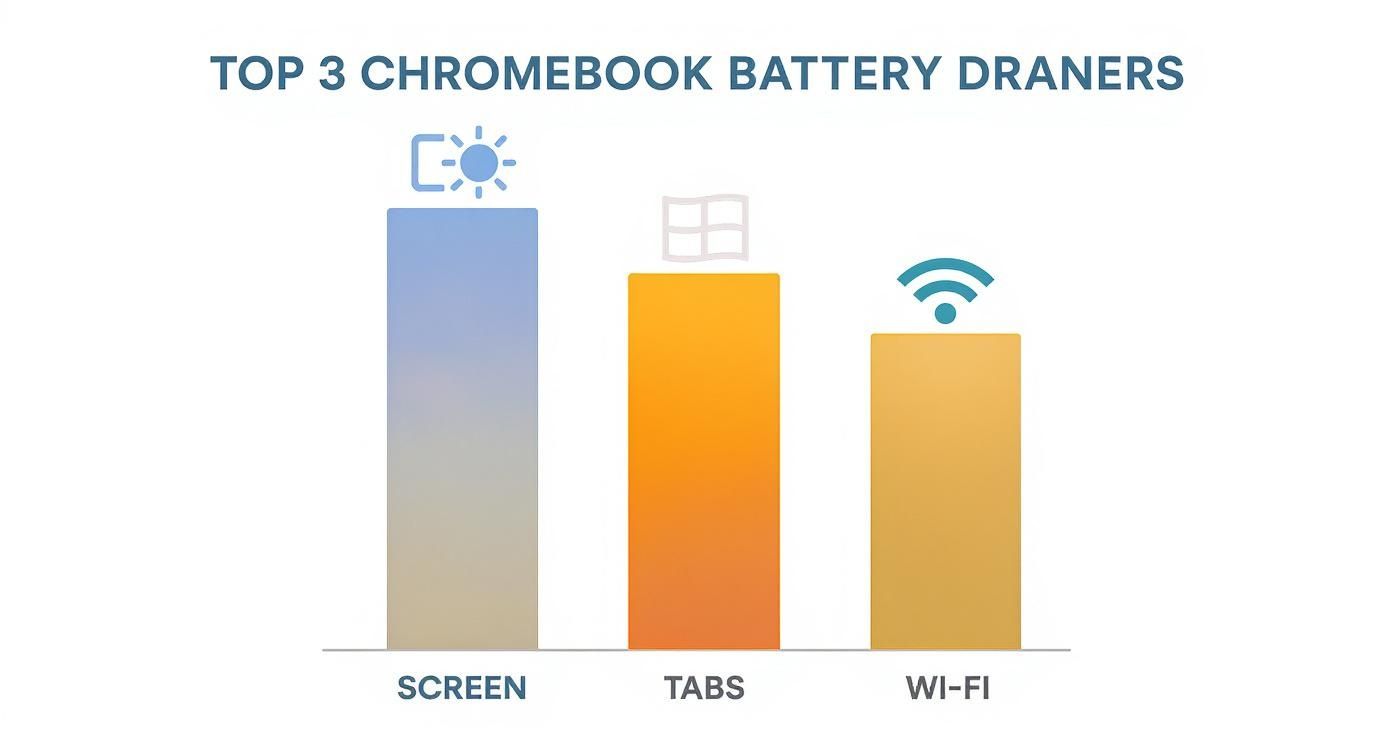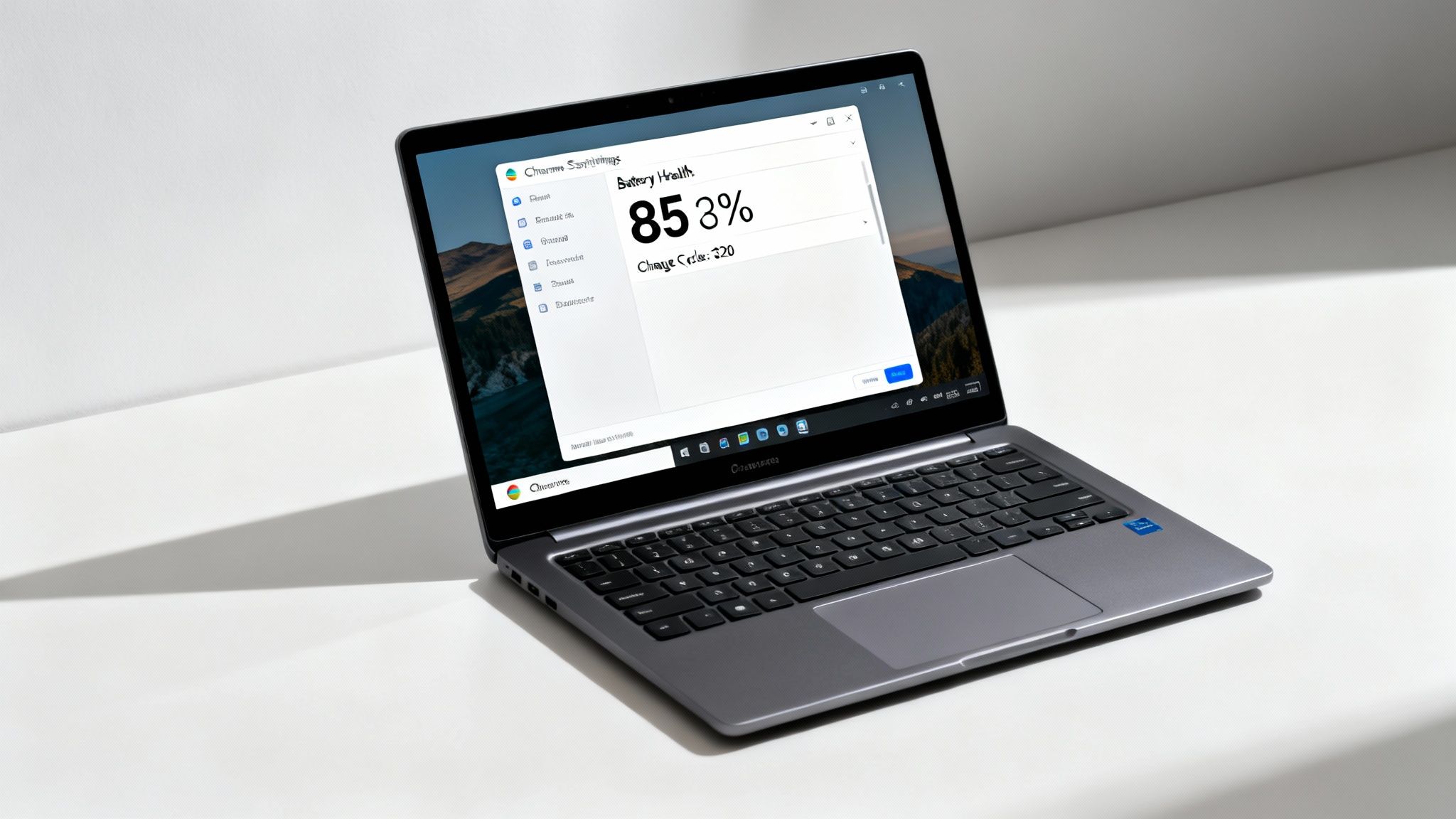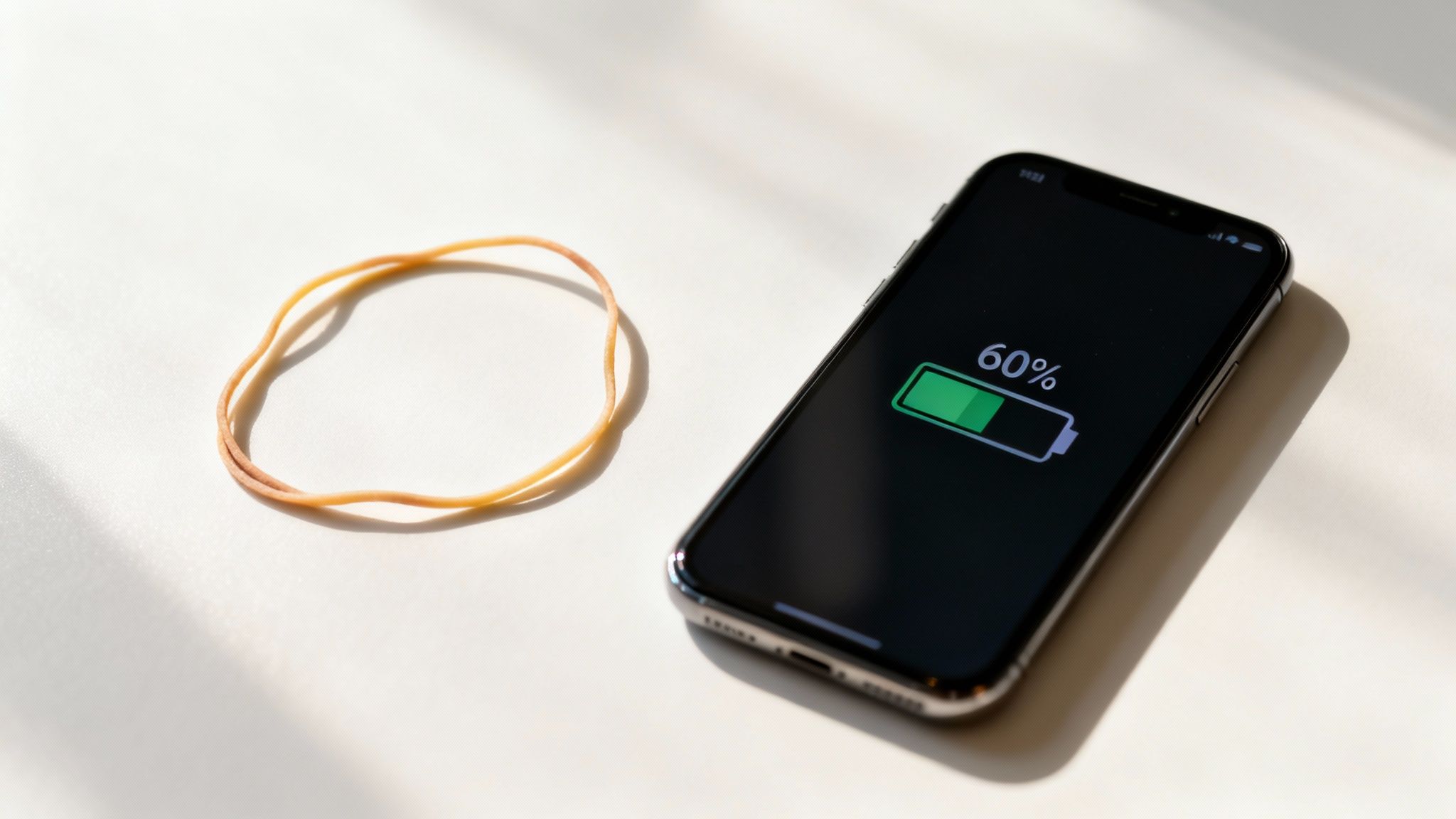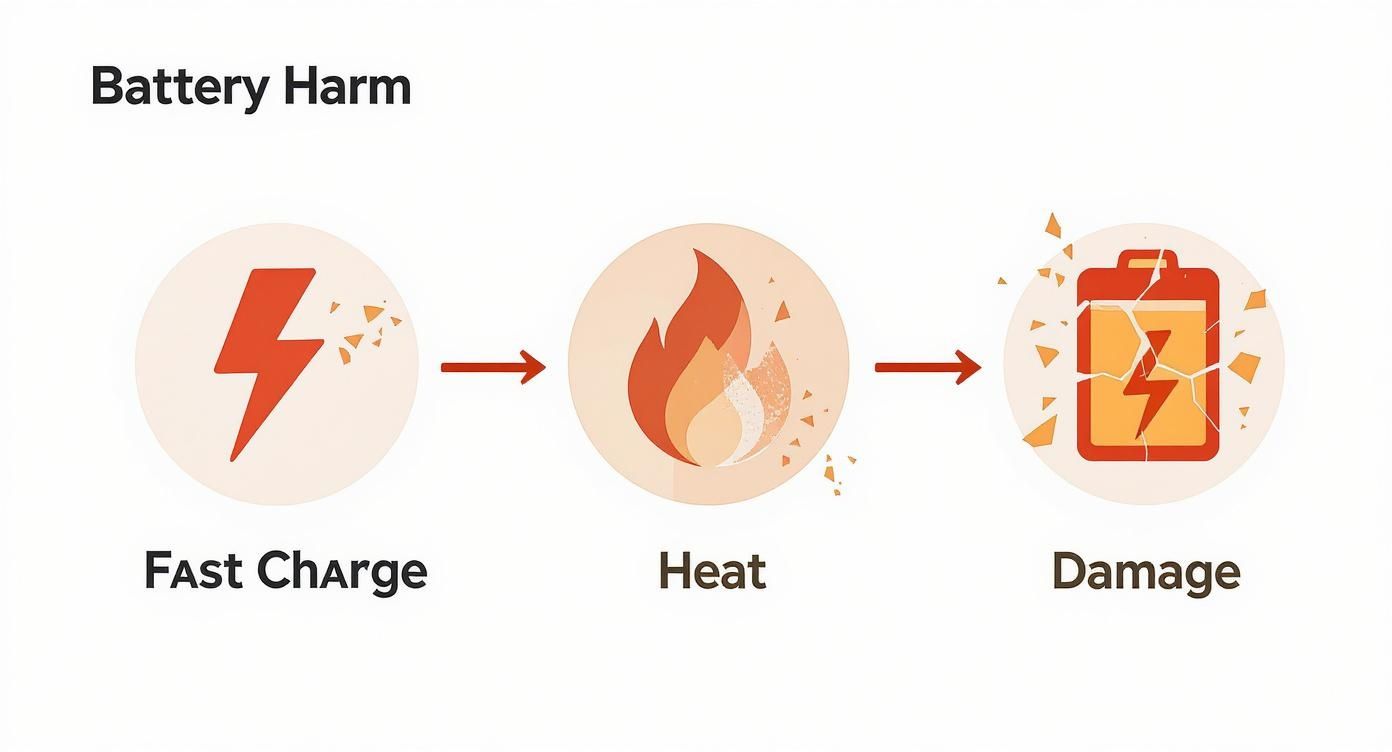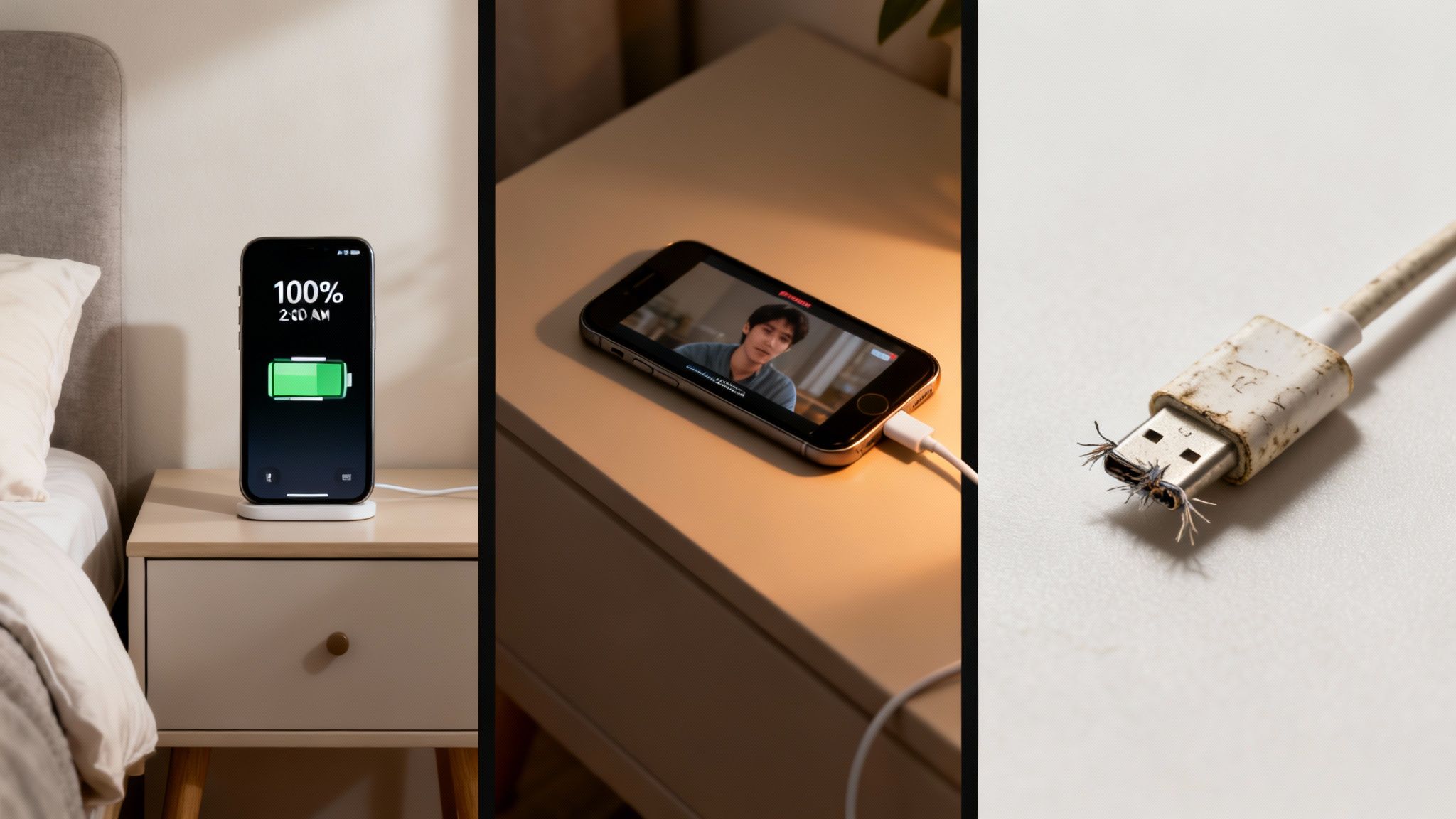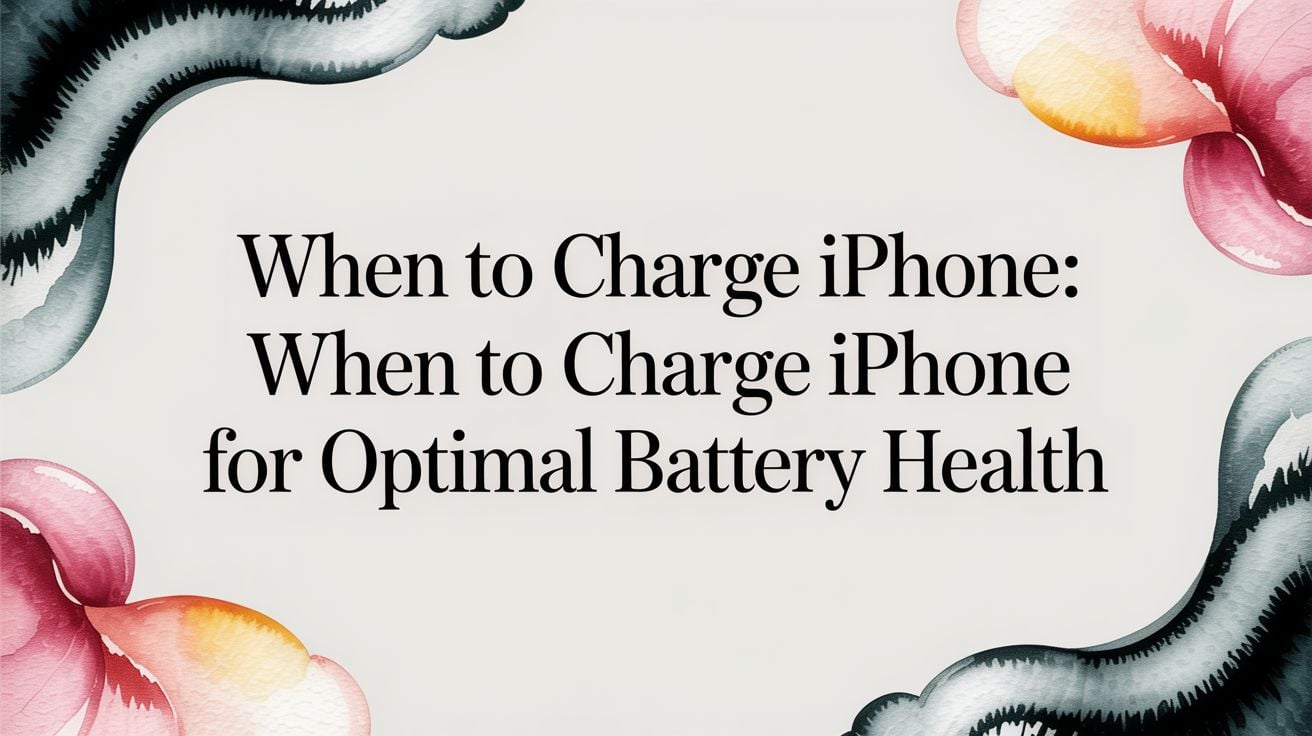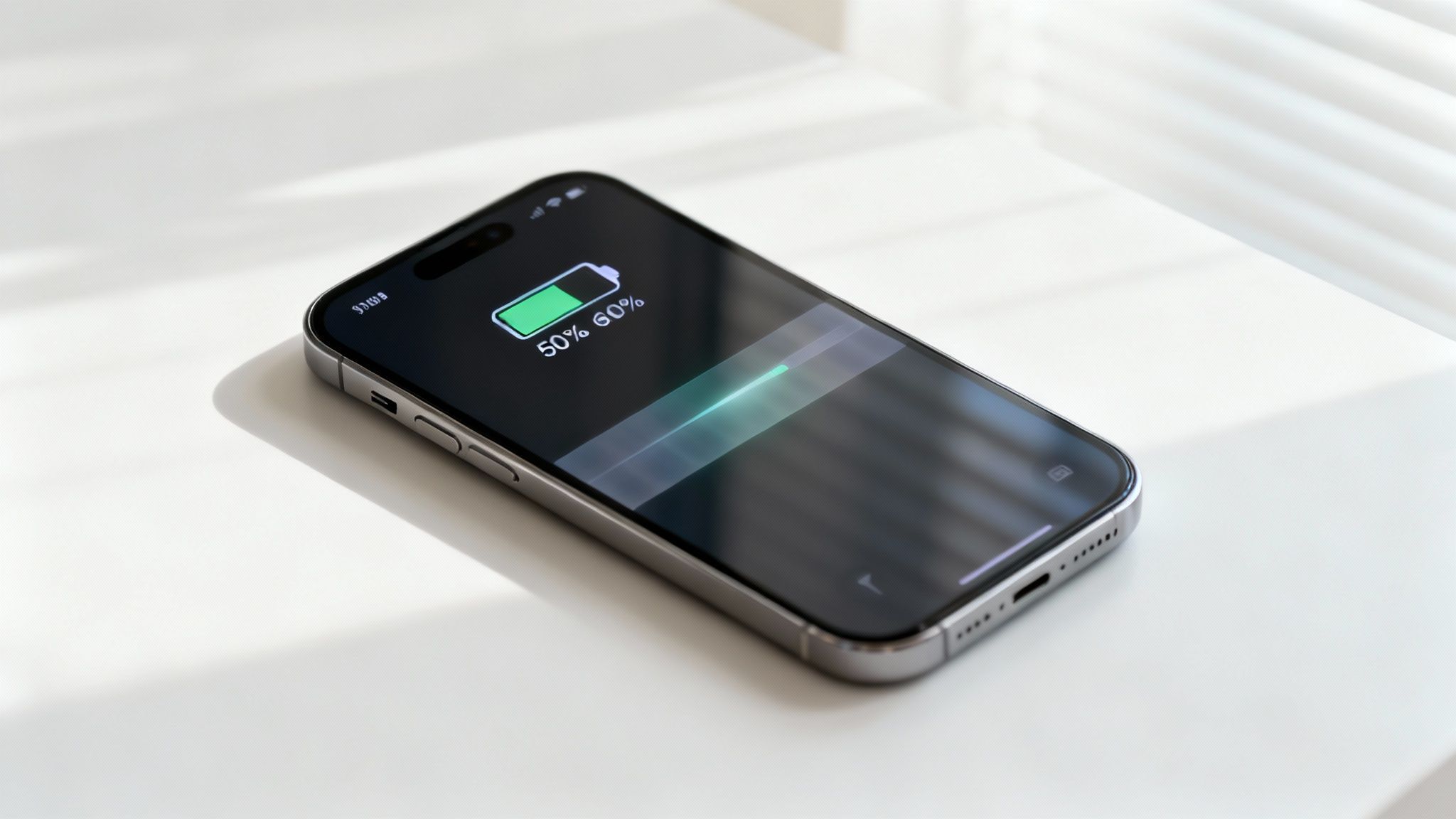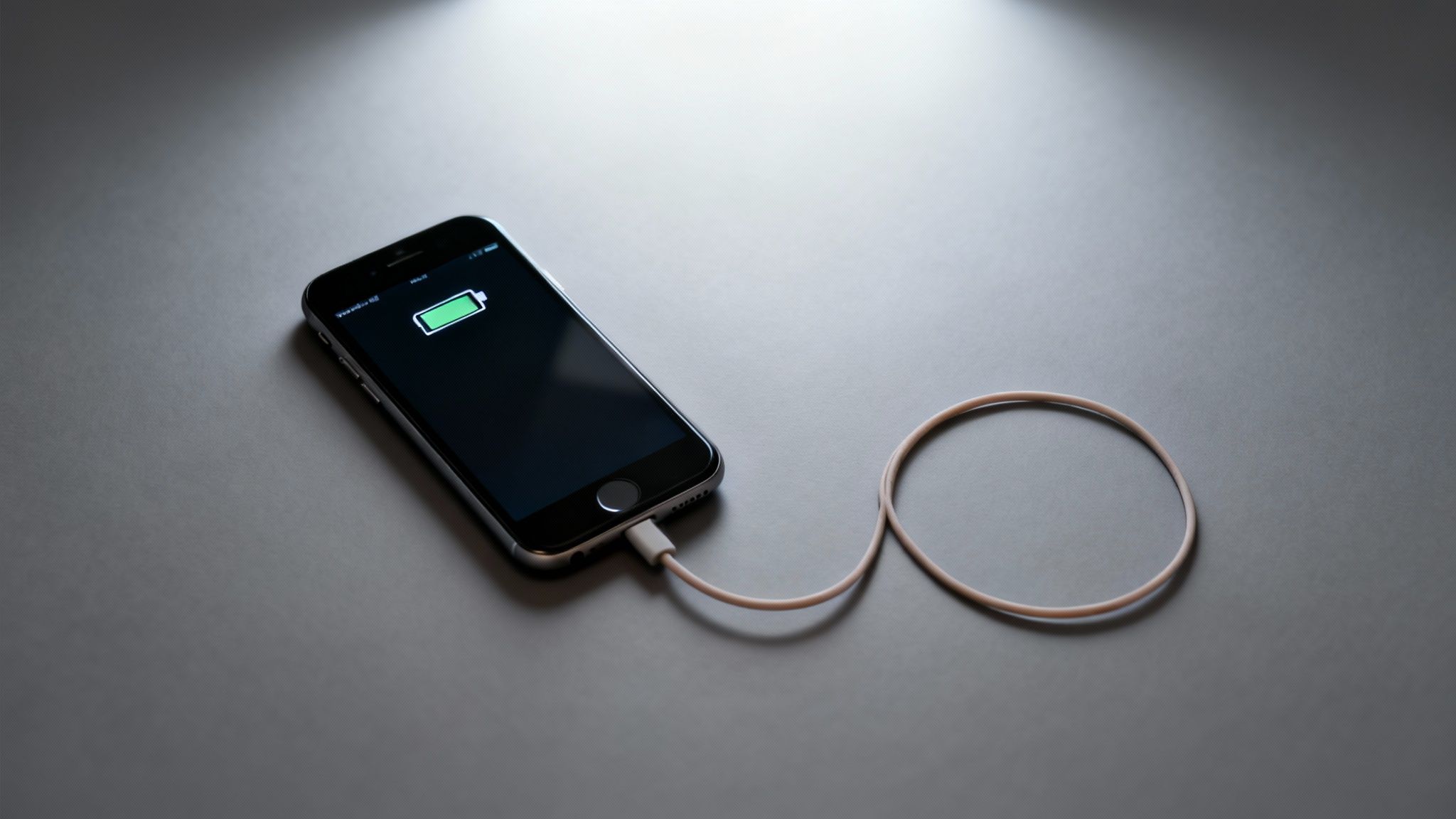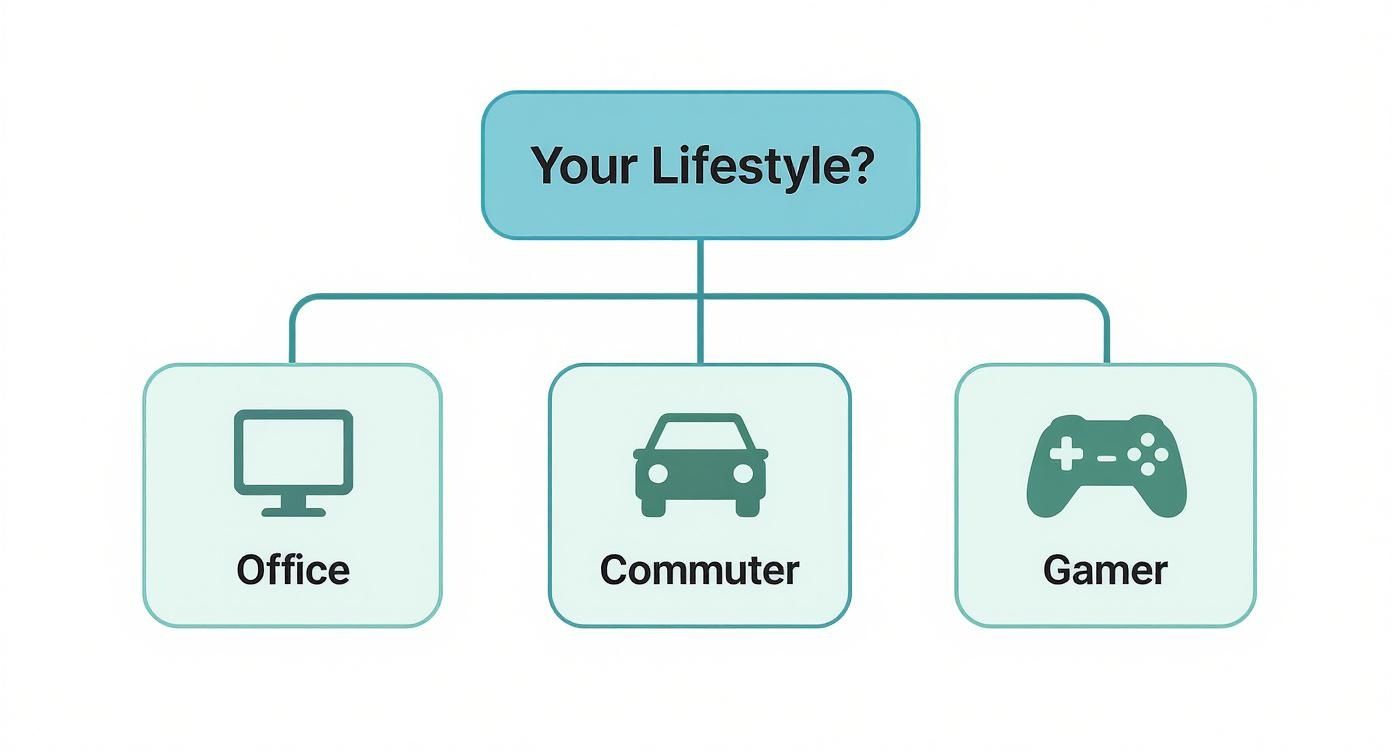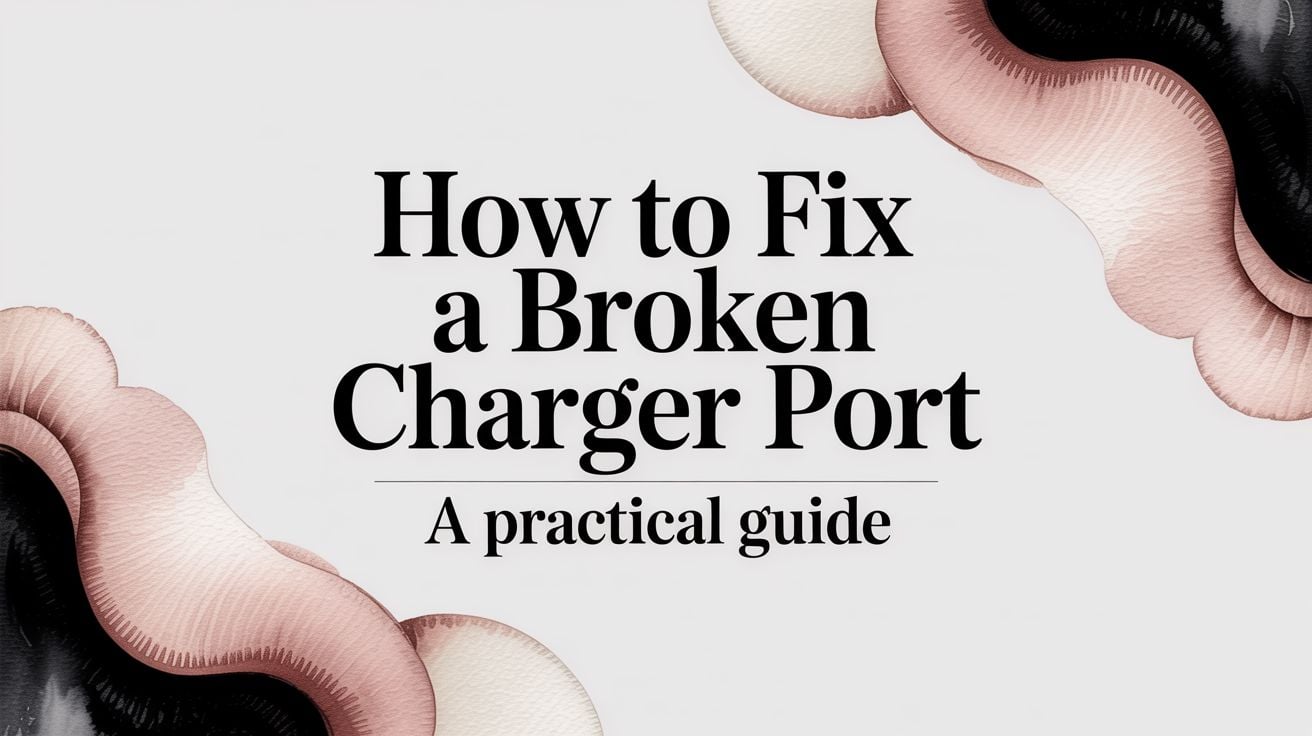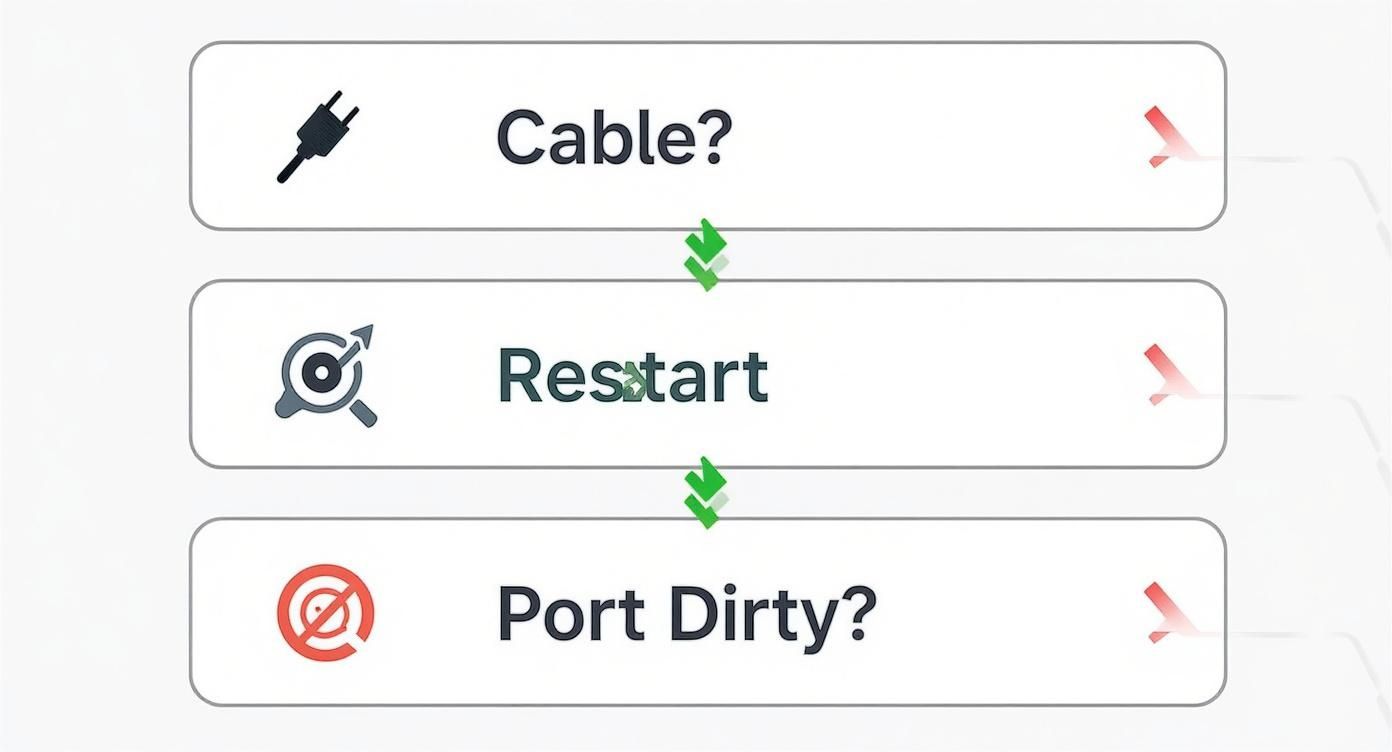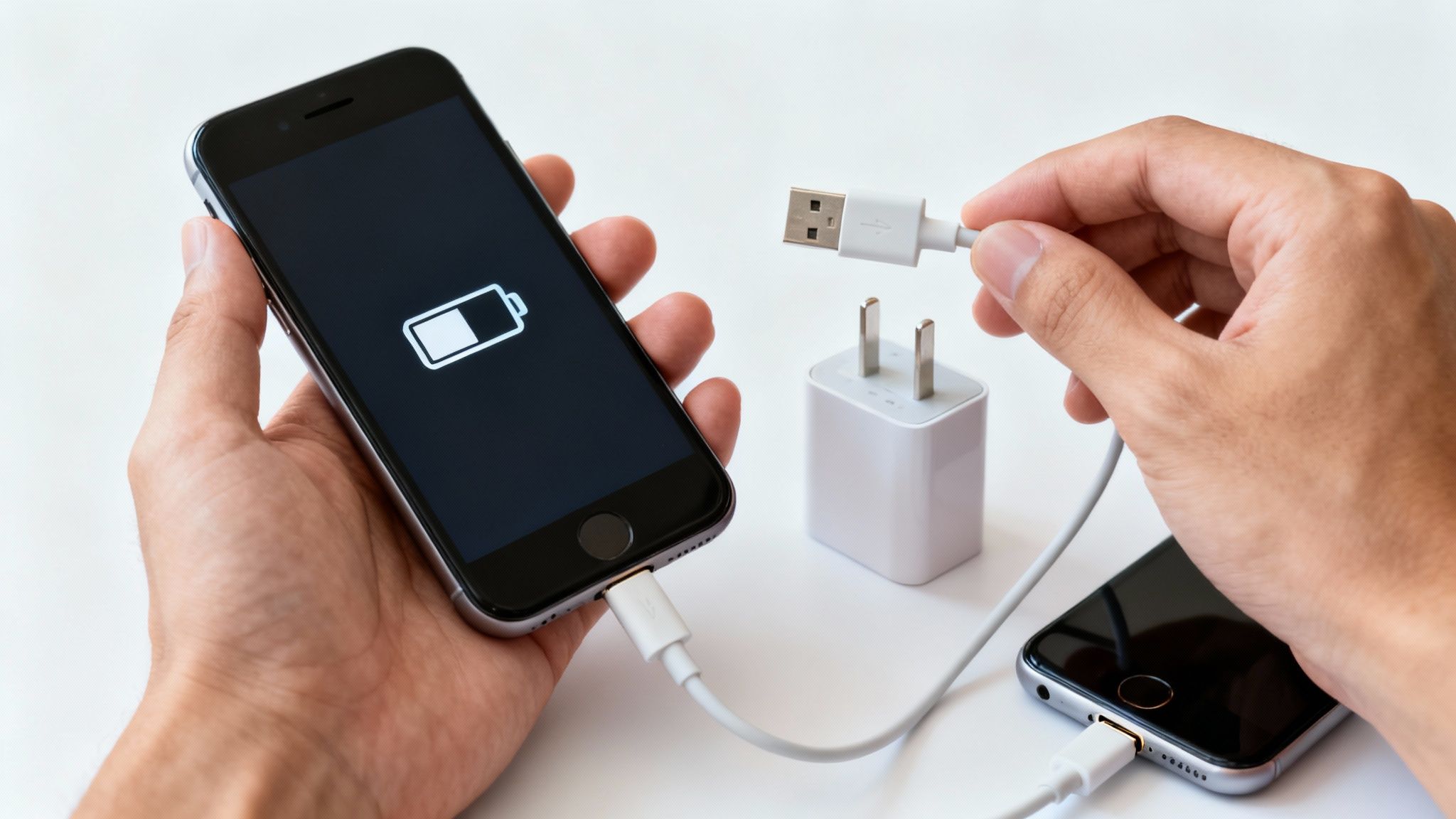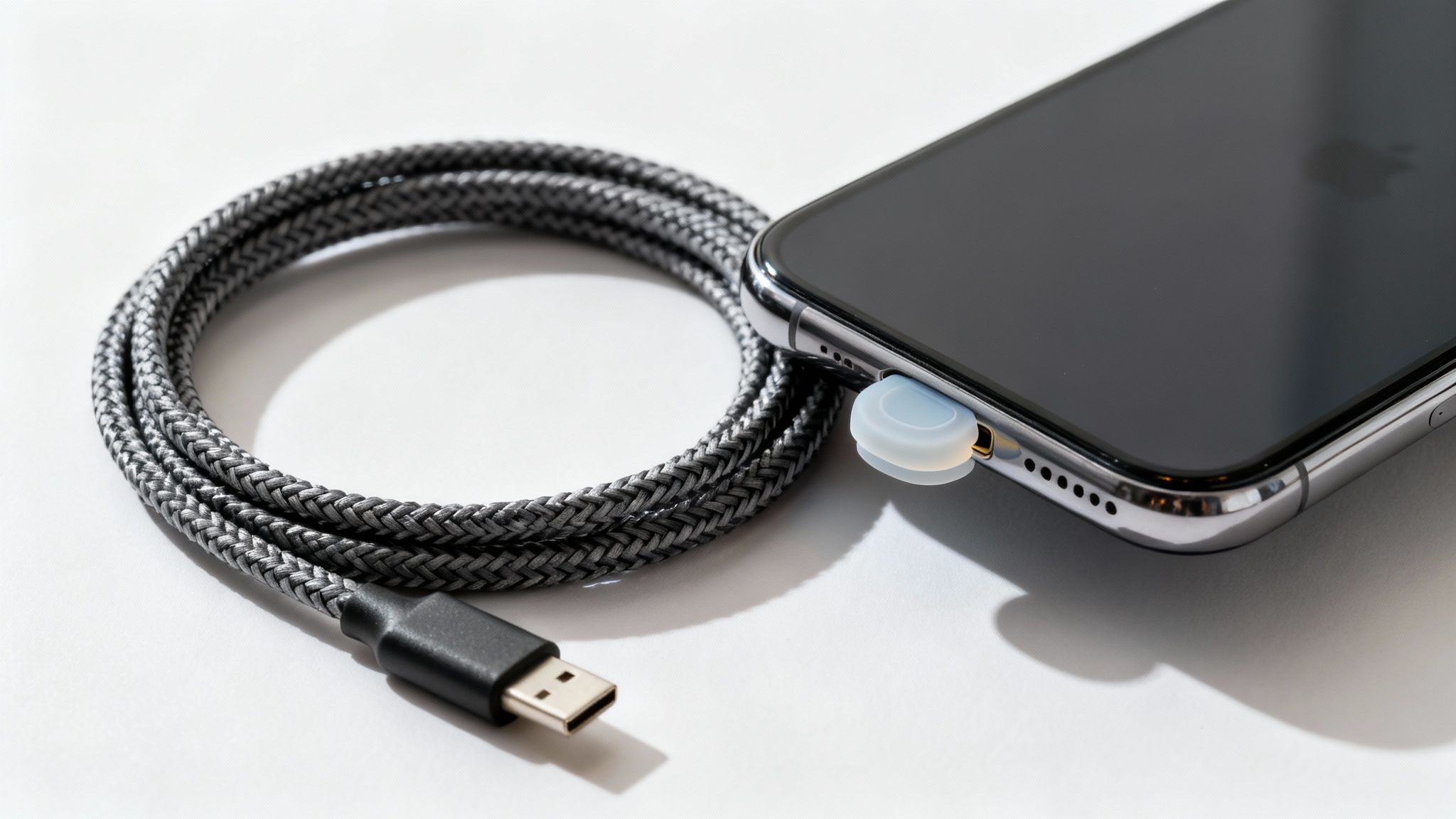Stop Charging at 80 Percent to Double Your Battery’s Lifespan
If you want your battery to last as long as possible, the single best habit you can adopt is to stop charging at 80% for your daily top-ups. Pushing a battery all the way to 100% might feel productive, but it puts a ton of stress on its insides, creating heat and speeding up wear and tear. It’s a small change that pays off big time in the long run.
The 80 Percent Rule: Why Full Charges Hurt Your Battery
Ever left your phone plugged in overnight and wondered if it’s actually good for it? Turns out, that common habit of pushing your device to a full 100% charge is one of the fastest ways to wear out its battery. This isn't just a myth; it's based on the science of the batteries that power nearly everything we rely on today.
Understanding Battery Stress
Think of your device's battery like a rubber band. You can stretch it to about 80% of its total length with little effort. But getting that last 20% requires a lot more force and puts the most strain on the material. Your battery goes through a similar process.
That final charging phase, from roughly 80% to 100%, is the hardest part. It forces tiny particles into an increasingly crowded space, which creates extra heat and puts physical stress on the battery's internal parts.
This isn't just a theory; the strain causes real damage over time. For a closer look at the factors understanding overall battery longevity, it becomes clear that charging habits are key. By simply capping your daily charges at 80%, you can:
- Slow Down Aging: Less stress means the battery’s parts wear down much more slowly, helping it hold a solid charge for longer.
- Keep Things Cool: Gentler charging cycles produce less heat, which is a battery’s number one enemy.
- Get More Out of Your Device: A healthier battery means you won't be looking for a replacement or a new device nearly as soon.
Charging Habits At a Glance: 80% vs 100%
To make it crystal clear, let's break down the real-world difference between these two charging approaches.
| Metric | Charging to 80% (Recommended) | Charging to 100% (Conventional) |
|---|---|---|
| Battery Stress | Low to moderate | High, especially from 80-100% |
| Heat Generation | Minimal | Significant, especially with fast charging |
| Long-Term Capacity | Preserves original capacity for longer | Faster decline and capacity loss |
| Typical Lifespan | Significantly extended | Shortened by up to 30-50% |
The numbers don't lie. Adopting the 80% habit is a straightforward way to protect your investment and keep your devices running strong for years, not months.
The Long-Term Payoff
We see solid proof of this in the electric vehicle industry, where battery health is everything. One study showed that EV owners who consistently followed the 80% rule still had 95% of their original battery capacity after a lot of driving. In contrast, those who regularly charged to 100% saw their capacity drop to just 85% over the same period.
The key takeaway here isn't to never charge to 100%. Think of a full charge as something you do for a long flight or a day away from an outlet. The goal is to make 80% your daily routine and 100% the exception. This simple shift is the most effective way to fight premature battery aging.
Using a dedicated hardware battery charge limiter like Chargie automates this entire process, making it effortless. In this guide, I’ll walk you through exactly how to set this up on all your devices.
How to Set an 80 Percent Charge Limit on Your Smartphone
Getting started with the 80% rule is a lot easier than you might think. Most modern smartphones have this feature built right into their software, so you can start protecting your battery's health in just a few taps. Let's walk through how to find and flip these switches on your iPhone or Android.
This simple diagram breaks it down perfectly: charging from 0% to 80% is low-stress for your battery. It's that final push from 80% to 100% that creates the high-stress environment leading to long-term damage.
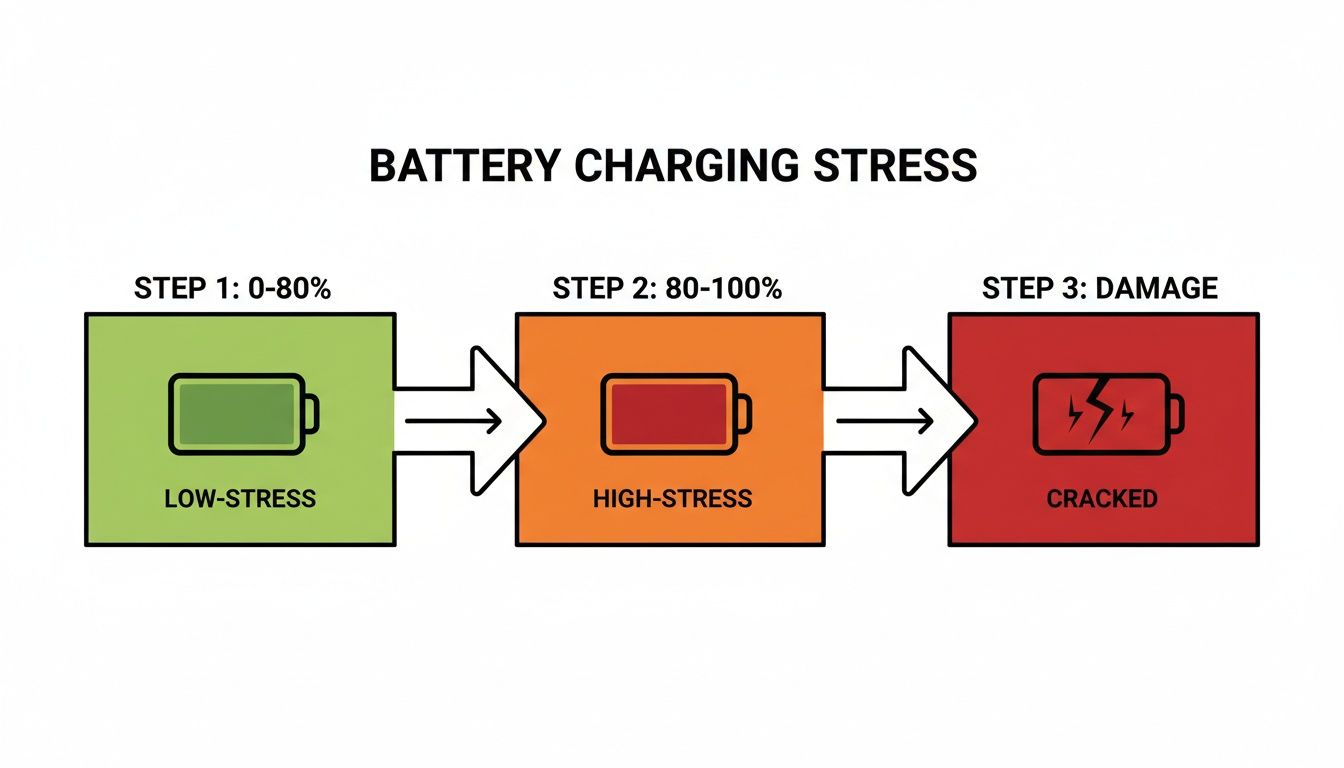
As you can see, that last 20% of the charge cycle is where the real strain happens. That makes it the most important phase to manage if you want your battery to last.
Taming Your iPhone's Charge
Apple has made it incredibly straightforward to stop charging at 80 percent, especially on their latest devices. If you're rocking an iPhone 15 model or newer, there's a direct setting waiting for you.
Here's how to get there:
- Jump into the Settings app.
- Scroll down a bit and tap on Battery.
- Head into Battery Health & Charging.
- Select Charging Optimization and just choose the 80% Limit option.
Once you enable that, your iPhone will automatically cut off the charge right at the 80% mark. Simple as that.
For those with older iPhones, you'll find a feature called Optimized Battery Charging. This is a bit different. It cleverly learns your daily routine and holds the charge at 80% overnight, only topping it off to 100% just before you typically grab it in the morning. While it's not a hard cap, it's still a fantastic way to reduce unnecessary battery strain.
Finding the Right Setting on Android
The Android world is a bit of a mixed bag since every manufacturer puts their own spin on the software. The good news is that the most popular brands have started to include similar battery-saving features.
On newer Samsung Galaxy phones, look for a feature called 'Protect battery'. You can usually find it by navigating to Settings > Battery and device care > Battery > More battery settings. Toggling this on caps your charge at 85%, which serves the same purpose of easing the stress on your battery's cells.
If you're a Google Pixel user, the feature is called 'Adaptive Charging'. It works a lot like Apple's optimized charging, learning your usage patterns to delay that final top-off. It's not a strict limit, but it’s designed to keep your phone from sitting at 100% for hours on end.
Keep in mind, the exact path to these settings can differ based on your Android version and phone model. Don't be afraid to use the search bar in your settings—just typing "battery" will almost always get you where you need to go.
What If Your Phone Lacks a Built-in Limit?
No built-in setting? No problem. If your phone doesn't have a native way to stop charging at 80%, you can still make it a habit with a few clever workarounds.
One of the most effective solutions is using an external hardware device that takes control of the power flow for you. For example, you can get very precise control and scheduling with the Chargie app, which works with a small physical device to enforce your charging rules perfectly.
If you prefer a low-tech approach, you've got options there too:
- Set a Timer: When you plug your phone in, just set a timer for around 60-90 minutes. In my experience, that's often enough to get you near the 80% sweet spot without going over.
- Use a Smart Plug: A simple smart plug can be programmed to switch off automatically after a certain amount of time, giving you a set-it-and-forget-it way to cut the charge.
Limiting Your Laptop Charge on Windows and macOS
Unlike our phones, laptops spend a huge amount of time plugged into a power outlet—sometimes for days on end. This constant connection makes them prime candidates for battery stress. When a laptop sits at 100% charge for long stretches, the battery wears out much faster.
Thankfully, both Windows and macOS have ways to get this under control and stop charging at 80 percent.
Making this one simple adjustment can dramatically extend the life of your laptop's battery. You'll thank yourself in a couple of years when your machine isn't dead the second you unplug it.
Setting Charge Limits on Windows Laptops
The world of Windows is a diverse one, so how you limit the charge usually comes down to your laptop's brand. Most manufacturers build their own power management software right in, giving you a direct way to control the battery’s maximum charge.
These apps are typically pre-installed, but if you can't find them, a quick trip to the manufacturer's support site will usually have the download you need. Here's a rundown of the usual suspects:
- Dell: You're looking for an app called Dell Power Manager. Dive into the 'Battery Information' or 'Battery Health' section, and you should find settings to customize charging, including setting a max percentage.
- Lenovo: The go-to tool here is Lenovo Vantage. Head over to the 'Power' section and switch on 'Conservation Mode.' This will cap the charge at a much healthier level, typically somewhere between 60-80%.
- HP: For many HP models, this setting is hiding in the HP Support Assistant app. If not, you might have to check the BIOS/UEFI settings under power management when you first boot up.
- ASUS: Fire up the MyASUS application. It has a feature called 'Battery Health Charging' that lets you pick a mode to limit the max charge to 80% or even 60% if you really want to maximize its lifespan.
What if you can't find a special app? The setting might be built into the laptop's startup system, known as the BIOS or UEFI. You get there by pressing a key like F2, F10, or Del right after you turn on your machine. Once you're in, look around for a 'Power Management' or 'Advanced' tab where you might find a battery charge limit option. This is great because it sets a limit that works no matter what Windows is doing.
For a deeper dive into these methods, you can learn more about how to preserve your laptop battery with these brand-specific tools.
Managing Your Charge on macOS
Apple handles things a bit differently with its 'Optimized Battery Charging' feature on MacBooks. It’s a smart, automated system that tries to learn your daily routine to manage battery health for you. The whole point is to delay charging past 80% until right before it thinks you’ll need a full battery.
Let's say you plug in your MacBook every night and unplug it around 7 a.m. macOS will see this pattern. It'll charge to 80% quickly, then pause, only resuming to hit 100% just before your morning alarm goes off. This trick dramatically reduces the time the battery spends under the high stress of a full charge.
To make sure this is working, head to System Settings > Battery. Click the little 'i' icon next to 'Battery Health' and confirm that 'Optimized Battery Charging' is toggled on.
While Apple’s system is fantastic for most people, it doesn't give you direct manual control to set a hard 80% limit. If your schedule is all over the place or you just prefer a fixed ceiling, you'll need a third-party app. Tools like AlDente are built for this, giving you the power to set a specific maximum charge percentage and take a more hands-on approach to protecting your MacBook’s battery.
Applying the 80 Percent Rule to Your Electric Vehicle
That habit of capping your charge at 80%? It’s even more important when you’re talking about the massive—and massively expensive—battery in your Electric Vehicle (EV). This isn't just some minor life hack; it's a core practice pushed by pretty much every major EV maker out there, from Tesla to Ford, to protect your long-term investment.
Just like your phone or laptop, an EV battery gets put under the most stress during that final sprint to a full charge. Pushing it to 100% every day for your regular commute creates a ton of unnecessary heat and speeds up the aging process that slowly eats away at your total driving range.
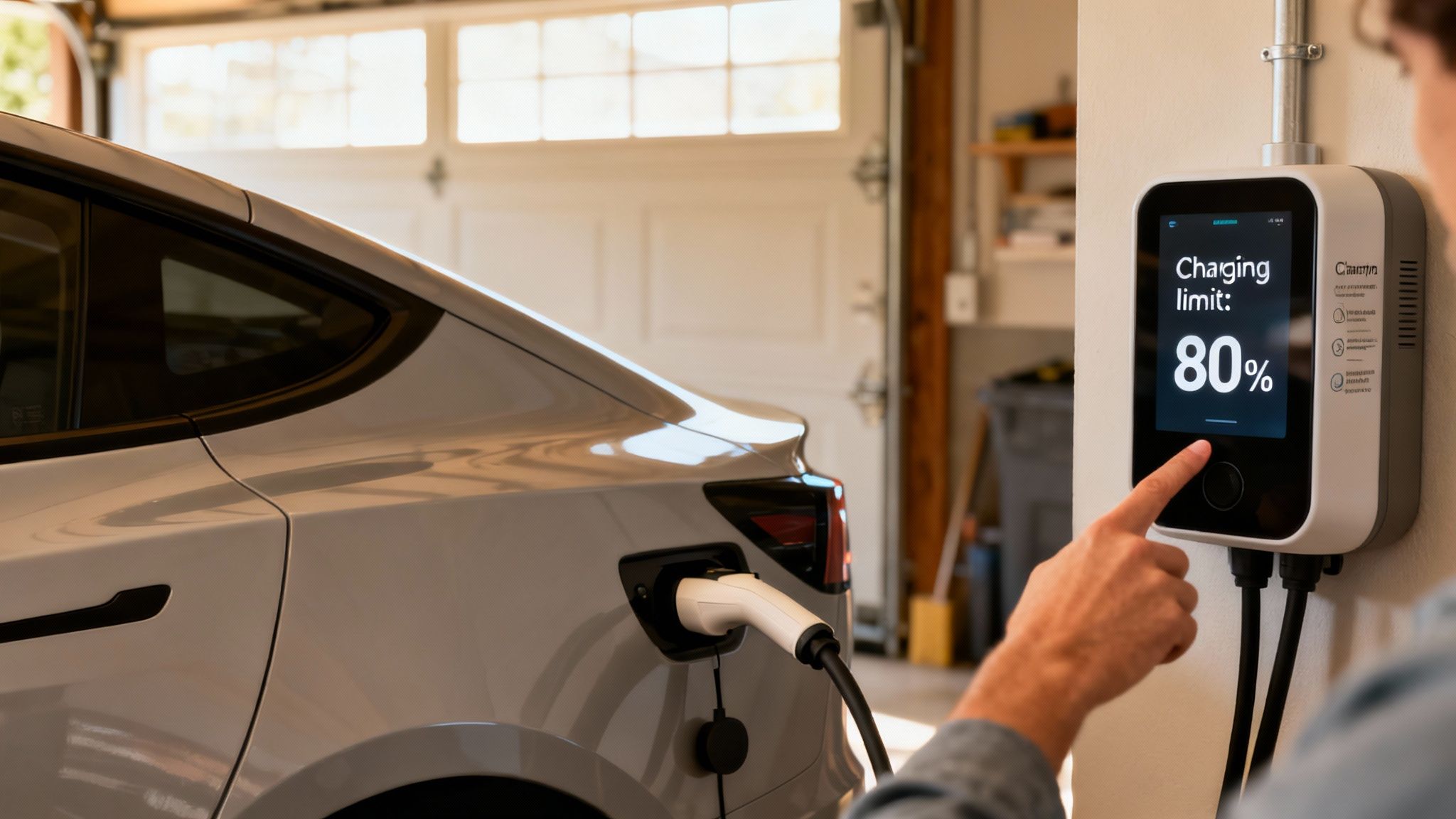
Simply making it a habit to stop charging at 80 percent is your best line of defense against premature battery wear. It’s what keeps your car performing like it should for years and years.
How to Set Your EV's Charge Limit
The good news is, carmakers have made this incredibly easy. You can usually set your charge limit in one of two places, and once you set it, you can mostly forget it.
- From the In-Car Display: Hop in your car and go to the vehicle settings on the main touchscreen. You're looking for a "Charging" or "Battery" menu. Inside, you’ll find a slider or a box where you can set your max charge level. For daily driving, just slide that down to 80%.
- Through the Companion App: Every modern EV has a smartphone app these days. Open it up, find the charging section, and you’ll see the exact same controls, letting you adjust the limit from your couch.
This whole process is dead simple, whether you're driving a Tesla, a Ford Mustang Mach-E, or a Hyundai Ioniq 5. The exact words might change a bit from car to car, but the goal is the same: tell your car when to stop. When it comes to an electric vehicle, especially for things like off-grid use, maximizing battery life starts with selecting the best RV battery for boondocking.
Why This Protects Your Investment
Stopping the charge at 80% is a huge deal for preventing heat-related stress, especially when you're hooked up to one of those ultra-fast DC chargers. Jamming the battery all the way to full on a fast charger risks overheating, which can slash its potential lifespan by as much as 40%.
Stick to an 80% limit, and you can reduce that natural aging by 30%. More importantly, you dramatically lower the chances of needing a painfully expensive battery replacement down the road, which can run anywhere from $15,000-$20,000.
Of course, there are times when you absolutely need that extra range. Before a long road trip, go ahead and charge to 100%. The key is to make 80% your default for everyday commutes and local driving. This simple habit preserves your EV’s range, its longevity, and ultimately, its future resale value.
Smarter Charging Habits for Everyday Life
While the big goal is to stop charging at 80% in your daily routine, think of it more as a guideline than a strict, unbreakable law. Life happens, and your charging habits need to be flexible. See the 80% limit as your go-to default setting, not another thing to stress about.
For example, charging to 100% is totally fine when you know you're going to need every last drop of power. Got a long flight coming up? Heading to an all-day conference or a road trip where outlets are a mystery? By all means, juice it up all the way. The real damage to batteries comes from the constant stress of being held at full charge day after day, not from the occasional, necessary top-up.
Beyond the 80 Percent Rule
Just as important as how much you charge is how low you let it go. Constantly running your battery down to 0% is just as hard on it as always pushing it to 100%. When a battery is totally drained, it can enter a deep-drained state, which makes it harder to revive and can even cause permanent damage.
A good rule of thumb is to plug your device in when it gets down to the 20-30% range.
By keeping your battery between roughly 30% and 80%, you’re letting it operate in its happiest, most stable, and lowest-stress zone. This one simple habit reduces wear and tear on the battery’s insides and can seriously extend its useful life.
Another huge factor is temperature. Batteries absolutely hate extreme heat and cold. Charging your phone on a sun-baked car dashboard or leaving it in a freezing car overnight can cause irreversible damage to its capacity. Always try to charge your devices in a comfortable, room-temperature spot to keep them healthy.
Your Charging Toolkit
The gear you use matters more than you might think. It's always best to stick with the original charger that came in the box or a high-quality, certified alternative from a reputable brand. Cheap, uncertified chargers can be a disaster—they often provide uneven power, lack proper safety controls, and can create a ton of excess heat. All of that is terrible for your battery.
Finally, let’s talk about slow vs. fast charging. While zapping your phone back to life in minutes is convenient, it also creates a lot more heat. If you're just charging overnight, there's really no need to use a powerful fast charger. A standard, slower charger will get the job done with far less heat stress, making it the healthier choice when you aren't in a rush.
Here is a quick cheat sheet to help you build better habits for all your devices.
Quick Guide to Healthy Battery Habits
| Do This | Avoid This |
|---|---|
| Charge to 80% for daily use. | Leaving your device plugged in at 100% for hours. |
| Plug in when the battery hits 20-30%. | Letting your battery drain completely to 0%. |
| Use the original or a certified charger. | Using cheap, uncertified chargers and cables. |
| Charge at room temperature. | Charging in extreme heat (like a car) or cold. |
| Use a slower charger for overnight charging. | Relying on fast charging for every single charge. |
Following these simple tips can make a massive difference in how long your device's battery performs at its peak. It's not about being perfect, but about being mindful.
Got Questions About Capping Your Charge at 80%?
Making the switch to the 80% rule always brings up a few questions. Trust me, you're not the first person to wonder about the details. Let's tackle some of the most common ones so you can feel good about this battery-saving strategy.
Is It Really Bad to Charge My Phone to 100% Every Once in a While?
Not at all. Think of the 80% rule as your daily routine, not a strict law you can never, ever break. Charging to 100% occasionally isn't going to cause any harm.
The real damage comes from the repeated, daily stress of keeping your battery stuck at that full-charge state, day in and day out.
So, if you know you've got a long day ahead—maybe you're catching a flight or heading out on a road trip—go ahead and top it off completely. Just make 80% your default for normal days, and your battery will thank you for it in the long run.
Will Stopping at 80% Actually Make a Difference I Can Notice?
Yes, absolutely. While you won't see a dramatic change overnight, the long-term payoff is huge. A battery that's consistently charged to 80% wears down far more slowly, which means it holds its charge much better over the years.
Fast forward two or three years. The device that was always charged to 80% will still have a respectable battery life that gets you through the day. In contrast, the one that was constantly pushed to 100% will likely be struggling to make it past lunchtime. It's a small investment in your device's future.
What if My Device Doesn't Have an 80% Limit Setting?
Don't worry, you're not out of luck. If your device lacks a built-in feature to stop charging at 80%, you can still make it a habit pretty easily. You don't need fancy software to make a big difference.
Here are a couple of simple, effective tricks I've used myself:
- Set a Quick Timer: When you plug in your phone, just ask your smart assistant or manually set a timer for about 60 to 90 minutes. For most phones, this is enough to get you right into that 80% sweet spot without overshooting.
- Use a Smart Plug: This is a fantastic "set it and forget it" solution. A basic smart plug can be programmed to shut off automatically after a set amount of time. It's perfect for overnight charging without the guesswork.
Does Leaving My Device Plugged In Overnight Damage the Battery if It Stops at 80%?
If your phone or laptop reliably stops charging at 80%, leaving it plugged in is worlds safer than letting it charge to 100% and sit there all night. Once the limit is hit, the system cuts the main power flow, preventing that high-stress state.
That said, the absolute best practice is still to unplug it once it's charged. This eliminates any minor "trickle" charging and prevents the small amount of heat from the charger itself from affecting the battery over time.
Think of it like this: 100% all night is bad. 80% all night is good. Unplugging when it's done is best.
Ready to make the 80% rule effortless? Chargie is a smart hardware device that automatically manages your charging schedule for you, ensuring your batteries stay healthy without you having to think about it. Protect your devices and extend their lifespan by visiting the official Chargie website today.



